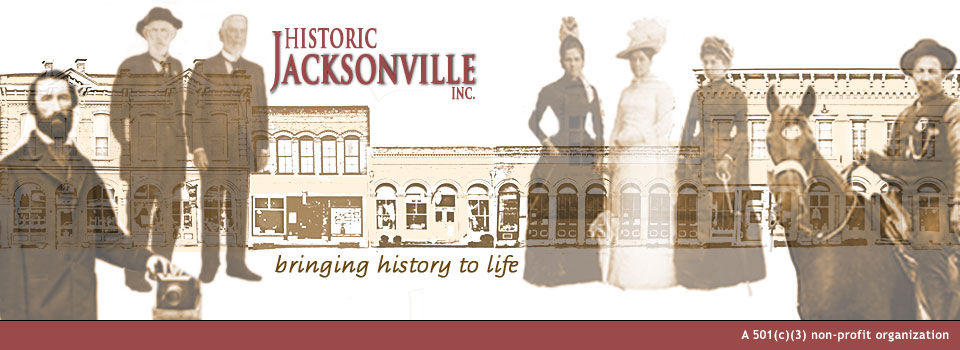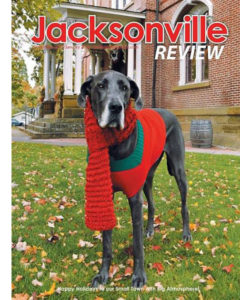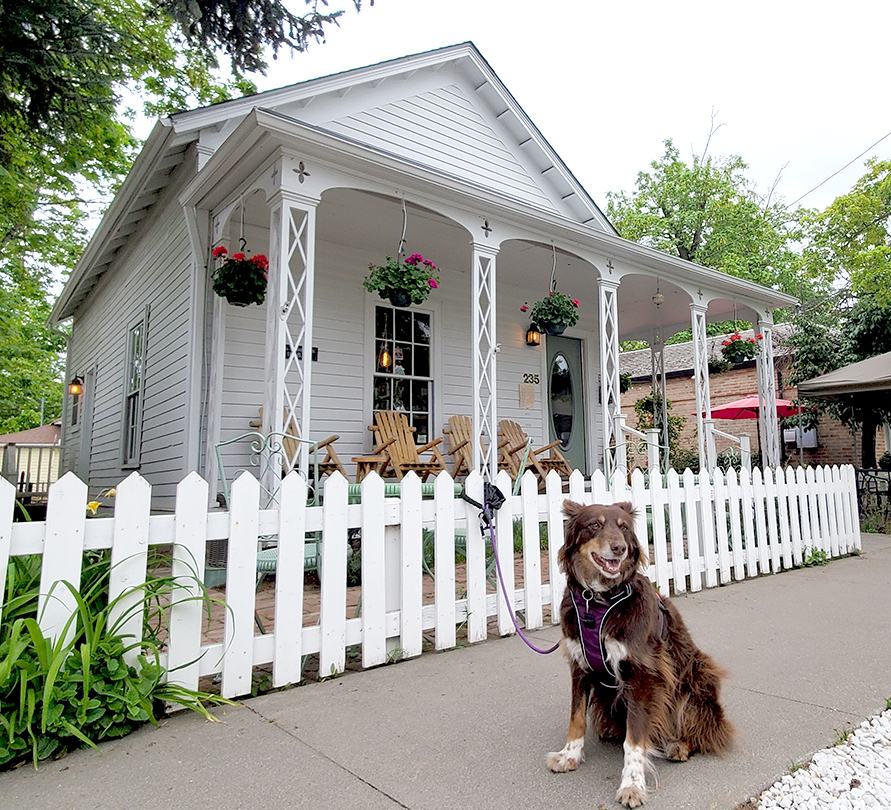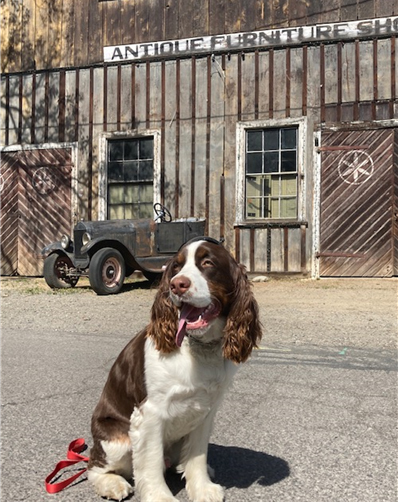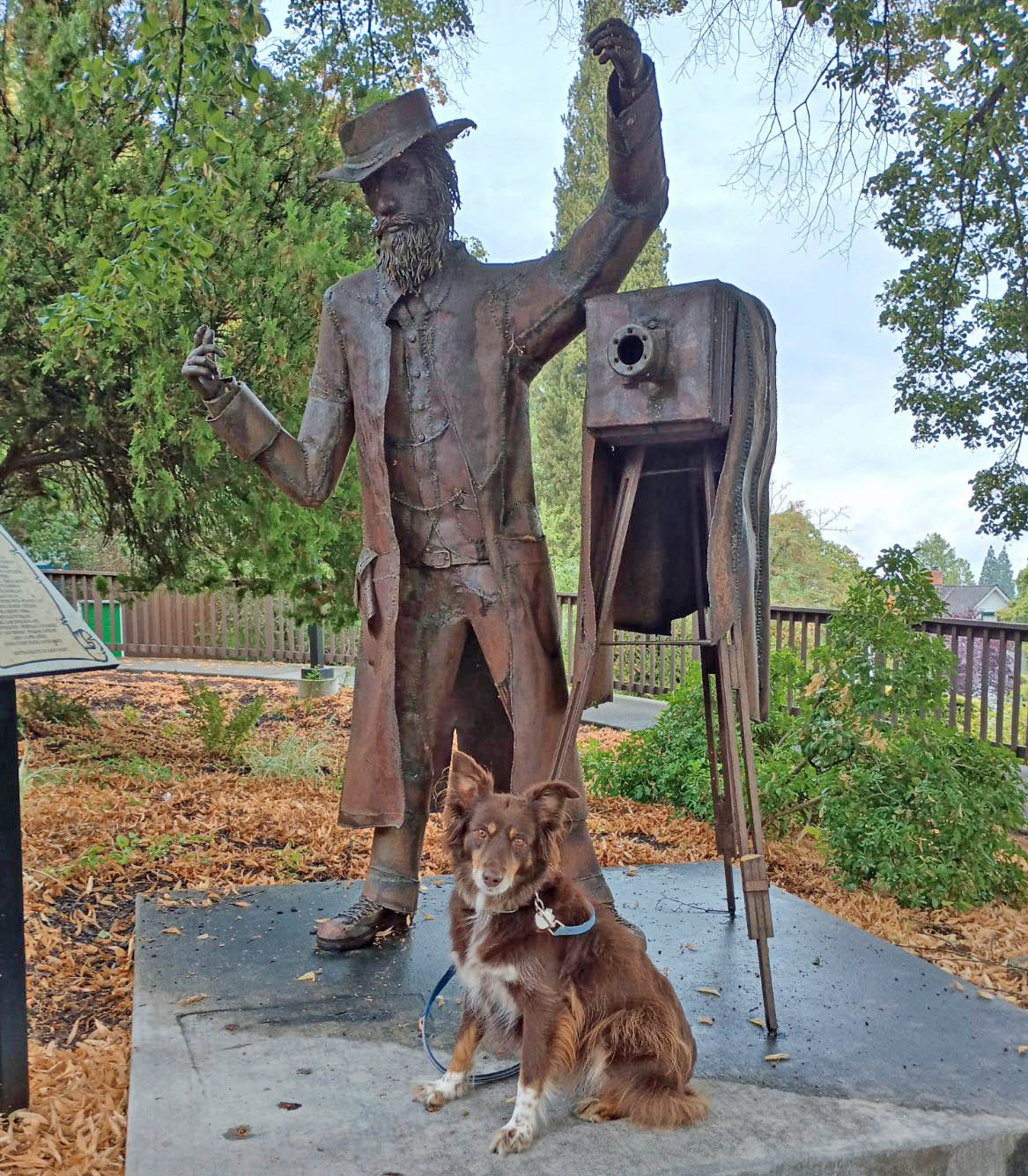 |
Peter Britt Statue
Gracie is excited about Britt Festivals upcoming summer season so today she is visiting the life-size statue of Peter Britt, who lived from 1819 to 1905, and after whom the festival is named. Standing in front of the main pavilion, this metal sculpture created by artist Ralph Starritt was dedicated on November 1, 2004. The statue is made from pieces of scrap metal welded together to create a good representation of Britt doing what he did best in his day, photography.
Although Britt is credited with being the father of Southern Oregon’s wine, orchard, and commercial horticulture industries, he is best known for his photographs. For 50 years he photographed the people, places, and events of Jacksonville and Southern Oregon. He was the first person to photograph Crater Lake and his photographs were influential in it being named a national park in 1902. His photographs of Jacksonville were also instrumental in it being named the first group of West Coast buildings on the National Historical Register—Jacksonville’s National Historic Landmark District!
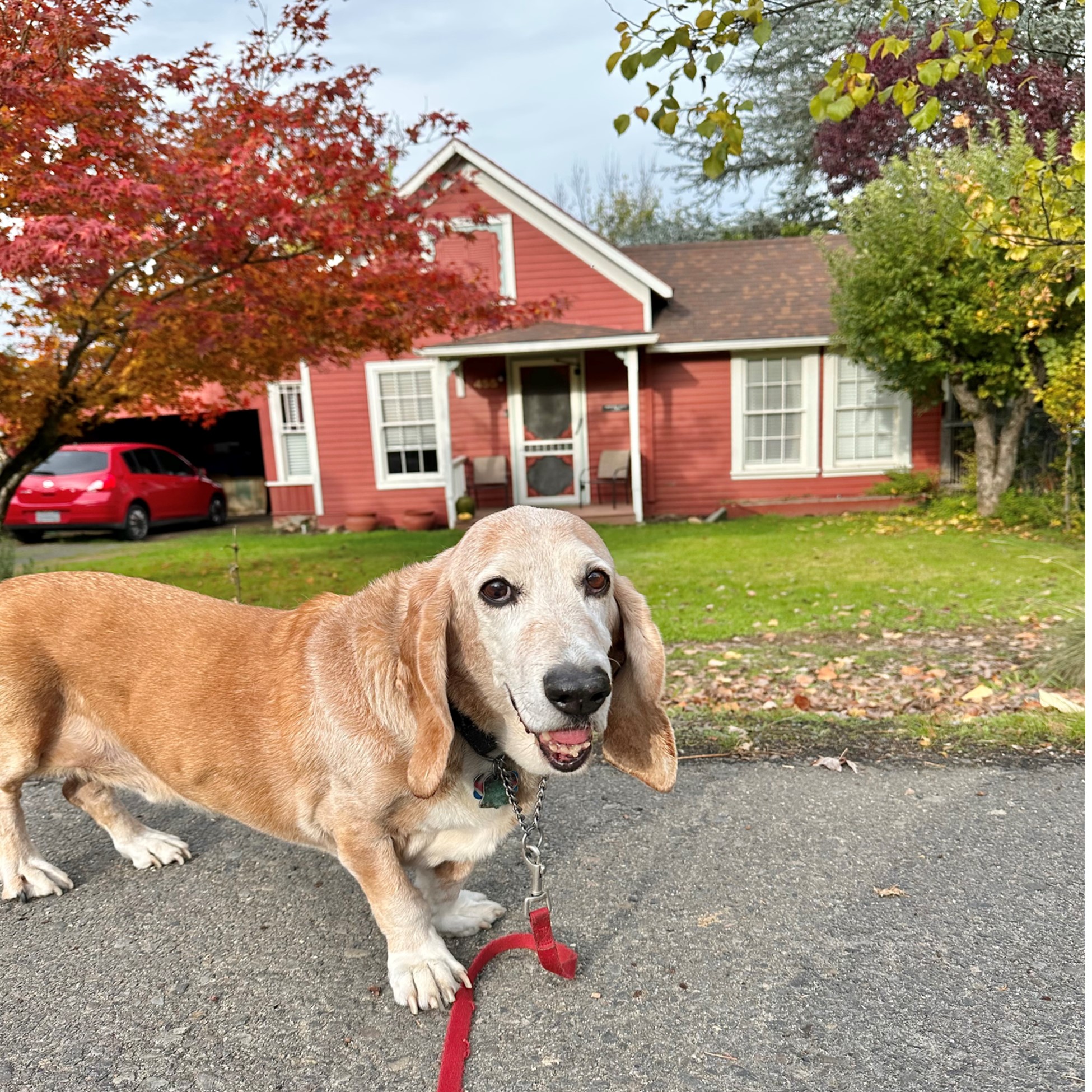 |
Magruder House
It is with great sadness that we share the loss of Trevor, the senior member of Historic Jacksonville, Inc.’s Walkabout Wednesday Club and our favorite “bagel” (Bassett-Beagle combo), who has sweetened many of our followers’ morning coffee. However, Trevor has continued to share the mission of our town’s four-legged history ambassador, Storm Large, with a few more visits to Jacksonville sites and their stories.
One of Trevor’s last visits was to the Magruder House, located at 455 E. California Street in Jacksonville. It was constructed in 1871 when Catherine Fleming Magruder was 60 and her husband Edmund, a retired farmer, was 70. A brief note in the April 1st edition of The Oregon Sentinel noted that the house was almost complete even though Catherine had purchased the land from the town’s founder, James Cluggage, only the previous month.
Fleming and Magruder had been married in 1856, second marriages for both, and both families were associated with prominent figures in Oregon history, boasting a U.S. Senator, U.S District Attorney, judges, an official lighthouse keeper, a postmaster, merchants, land barons, and more. Edmund died in 1875; Catherine in 1882. The house has passed through numerous hands in the interim but continues to be a private residence.
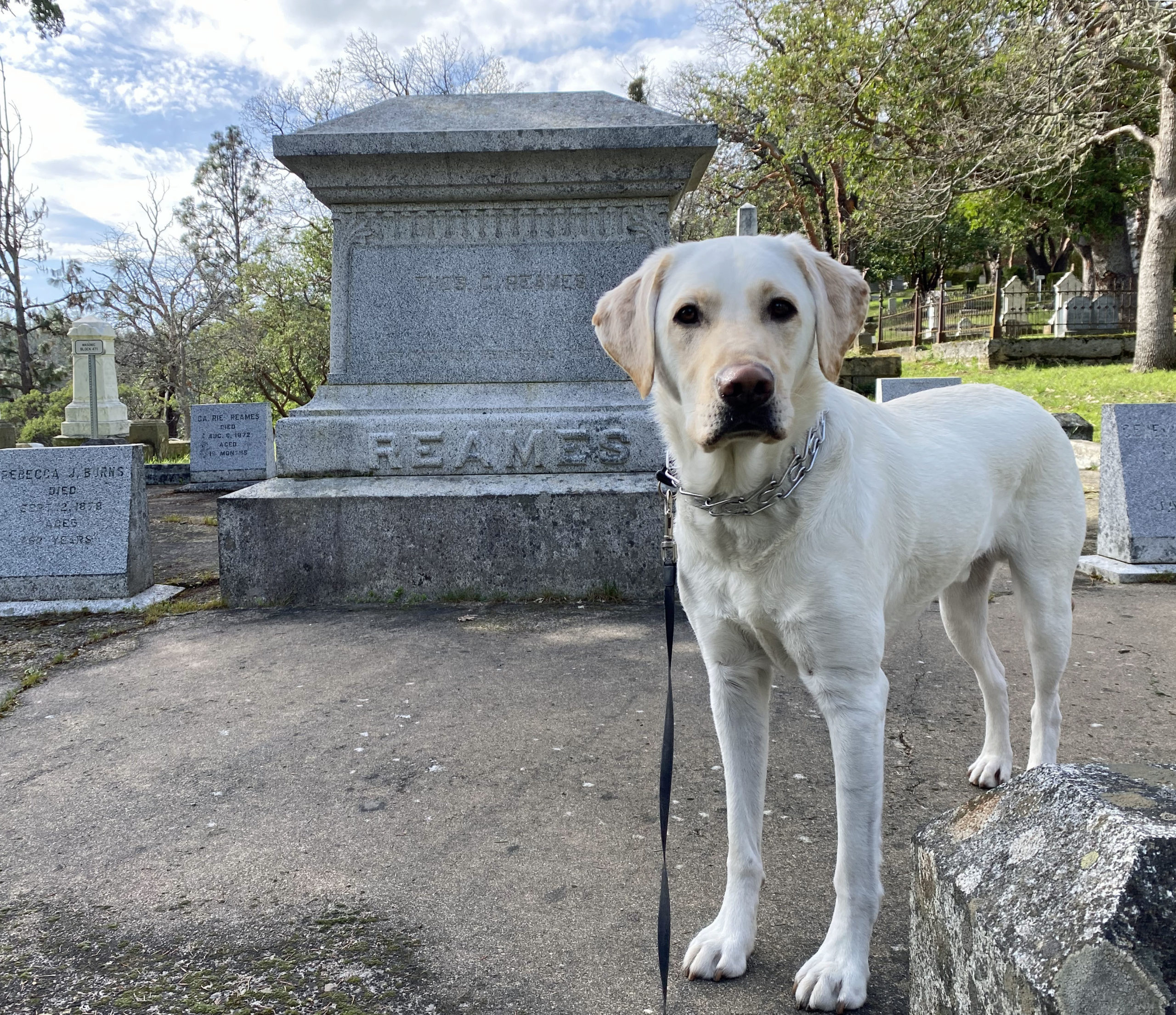 |
Reames Headstone
Mozzie, the club’s playful yellow lab tour guide, is back in Jacksonville’s Pioneer Cemetery, one of his favorite places, visiting the Thomas G. Reames family plot.
In 1852, a 13-year-old Reames had driven a family wagon across the Oregon Trail and then worked as a stevedore with his father for the Hudson Bay Company. The lure of gold and land brought the family to Southern Oregon 2 years later. By the time he reached his 20s, Thomas had experienced stevedoring, mining, farming, and blacksmithing, before moving to Jacksonville in 1864.
Over the next few years, Reames served as deputy sheriff then sheriff, ran a livery stable, and opened a prosperous mercantile business. He eventually became partners with his neighbor, C.C. Beekman, in the Beekman & Reames Banking House.
Reames also had a taste for politics, serving multiple terms on the Jacksonville City Council, including several stints as mayor. President Grover Cleveland appointed Reames as Postal Inspector for Oregon, Washington, Idaho, Montana, and Alaska. At the time of his death in 1900, he was Superintendent of Schools.
Reames was also one of the most prominent members of the Oregon Masonic fraternity. A 32nd degree Mason, he was Worshipful Master of Jacksonville’s Warren Lodge No. 10, a charter member and Eminent Commander of the Ashland Lodge, and Grand Master of all the Oregon lodges. In those capacities, he laid the cornerstone of the historic Jackson County Courthouse, now Jacksonville’s city offices.
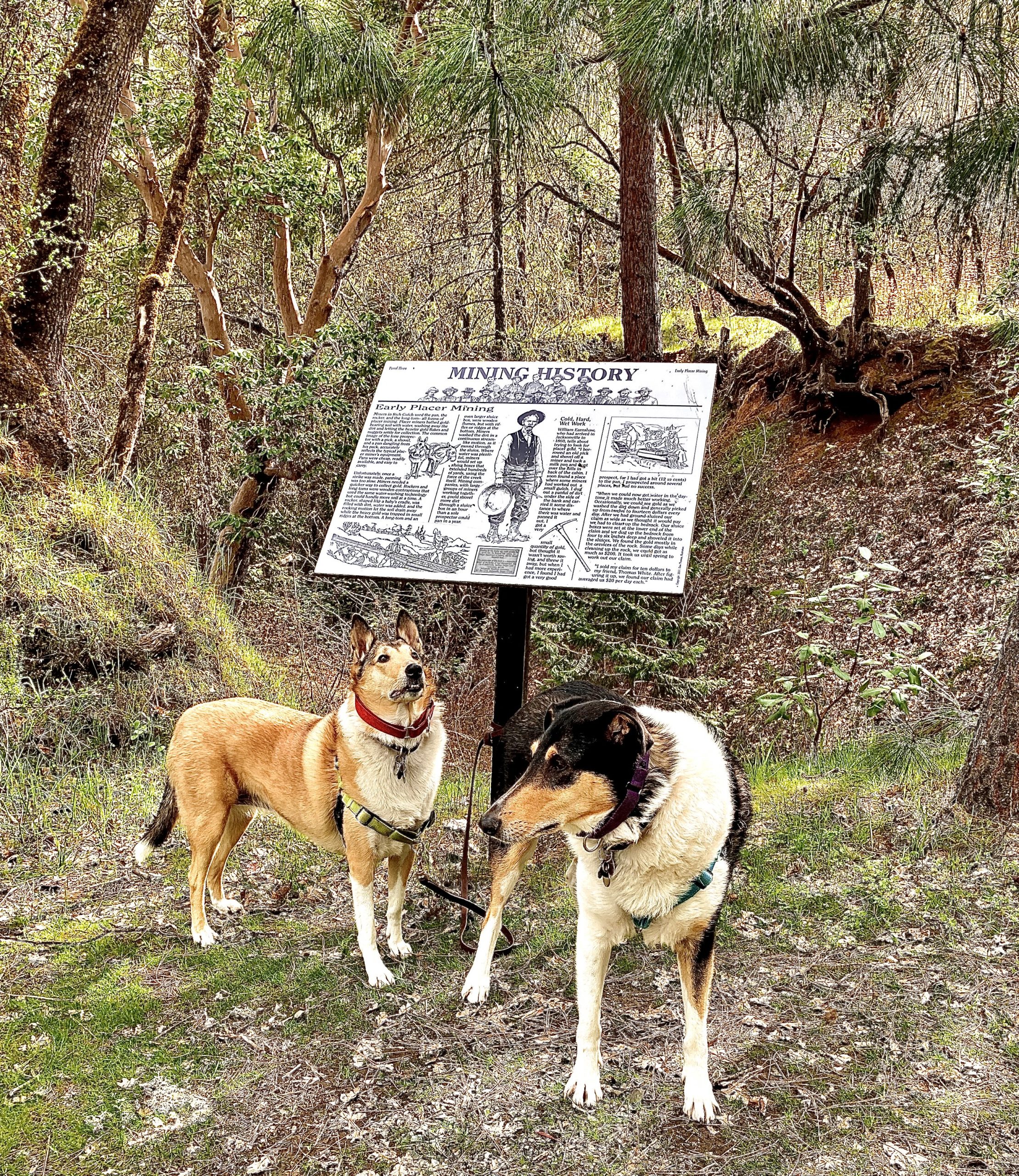 |
Rich Gulch
With spring’s wildflowers in bloom, our smooth collie club members, Ariel and Caliban, are ready to explore the Jacksonville Woodlands’ Rich Gulch Trail that stretches between the trail head at the top of W. Fir Street and S. Oregon Street. It follows old hydraulically mined gulches and glory holes dating to the 1860s.
The term “Rich Gulch” was actually applied to the entire area after 2 “packers” hauling goods from Portland to the Northern California mines publicized their discovery of gold in early 1852. They had learned about gold when they stopped for the night with the local Indian agent whose son and hired hand had found gold in Jackson Creek in the fall of 1851. The packers, James Clugage and James Poole, struck pay dirt in nearby Daisy Creek and filed donation land claims when they arrived in Yreka.
Rather than keeping the discovery to himself, Clugage publicized their find! Within days, a thousand miners poured over the Siskiyous and began mining the area. And that was the beginning of Jacksonville! Poole returned to mining; Clugage became rich selling parcels from his donation land claim.
[As an incentive to settle the Oregon Territory, in 1850 Congress allotted free land to settlers who built a residence and cultivated their acreage for 4 years. In 1852, individuals could claim 160 acres; couples, 320 acres.]
The location of the original Rich Gulch may be open to question. In January of 1867, a major rainstorm overflowed Jackson Creek, washing out old mining claims and flooding businesses and homes. A newspaper account feared that the deluge would break through an old mining tunnel, cutting a new channel and “discharging into Rich Gulch at the [County] clerk’s office.” That would seem to place the actual “Rich Gulch” in the in the vicinity of what is now Jacksonville’s “Courthouse Square” and New City Hall!
Regardless of location, Jacksonville remains a “Rich Gulch” with multiple attractions to offer us all!
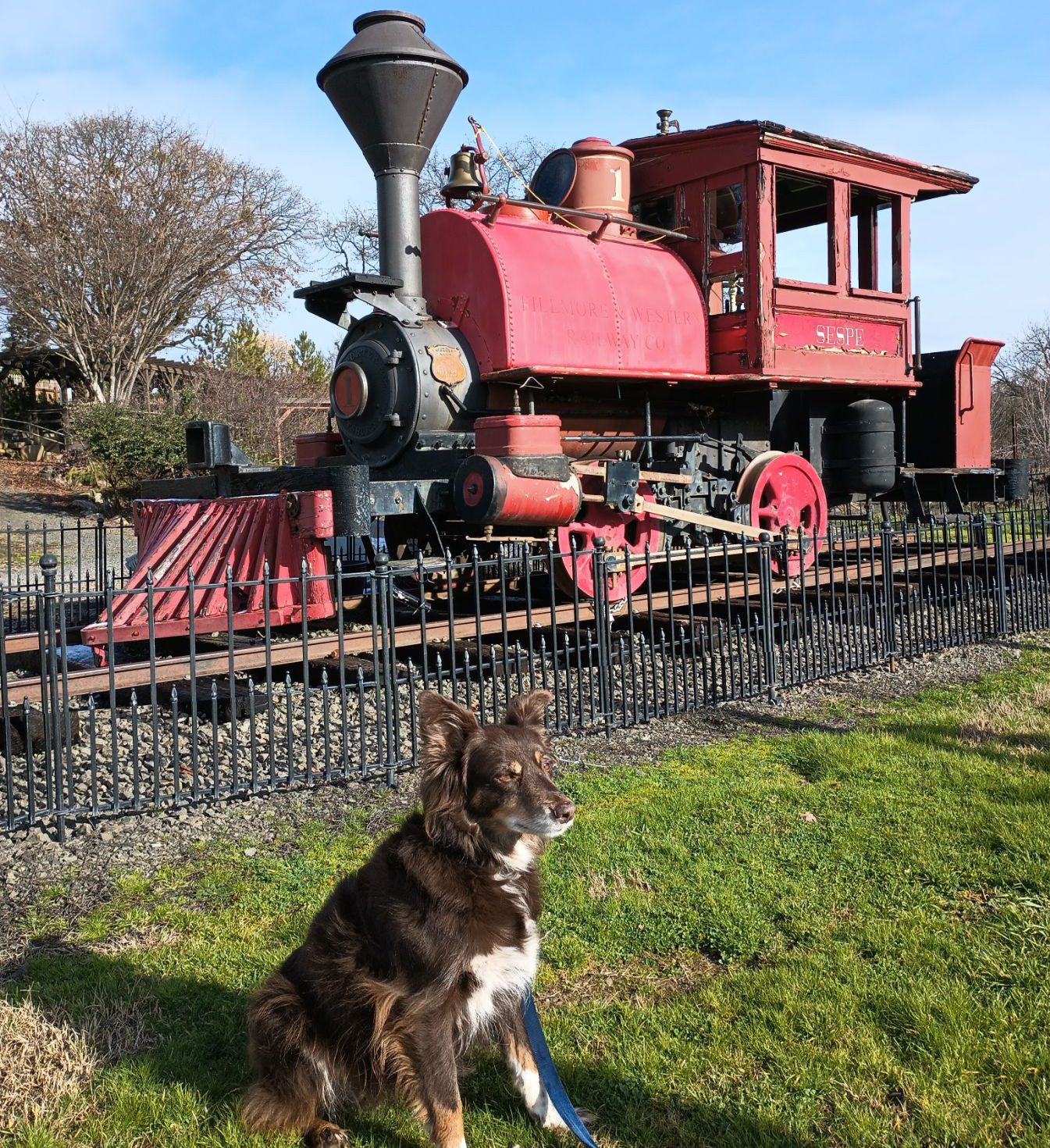 |
Engine #1
Gracie, our inquisitive red Australian Shepherd, is keeping watch over the Rogue River Valley Railway’s Engine No. 1. The railway, which operated from 1891 until 1925, was Jacksonville’s attempt to maintain regional economic supremacy after the Oregon & California railroad line bypassed the town in favor of the flat valley floor. The RRVR hauled gravel, bricks, timber, crops, livestock, mail and passengers over a 5-mile, single track spur line that connected Jacksonville with Medford.
The RRVR’s first engine—Engine No. 1—was put into service in May of 1891. Nicknamed Dinky, the Peanut Roaster, the Tea Kettle, and the Jacksonville Cannon Ball because of its small size, Engine No. 1 soon proved too underpowered to haul the heavier freight loads up the 3% grade from Medford and was relegated to passenger service, pulling a single Pullman car. In 1895, the little 12-ton Porter engine was sold.
It changed hands a number of times over the years until it was badly burned in a logging camp fire. In 1946, Helen O’Connor spotted the abandoned engine in Cottage Grove, OR, and bought it for her husband Chadwell, a steam engine enthusiast, inventor, and a Sci-Tech award and Oscar recipient from the Academy of Motion Picture Arts and Sciences. The couple had Engine No. 1 rebuilt from the original Porter blueprints.
Over the next 6 decades, the little engine saw new life as a private plaything, a Cottage Grove tourist promotion, transportation for families wanting to cut their own Christmas trees, and a “prop” in commercials and motion pictures until Mel and Brooke Ashland arranged for its purchase and restoration in 2014. Engine No. 1 now sits on original track on the Bigham Knoll Campus at the end of East E Street.
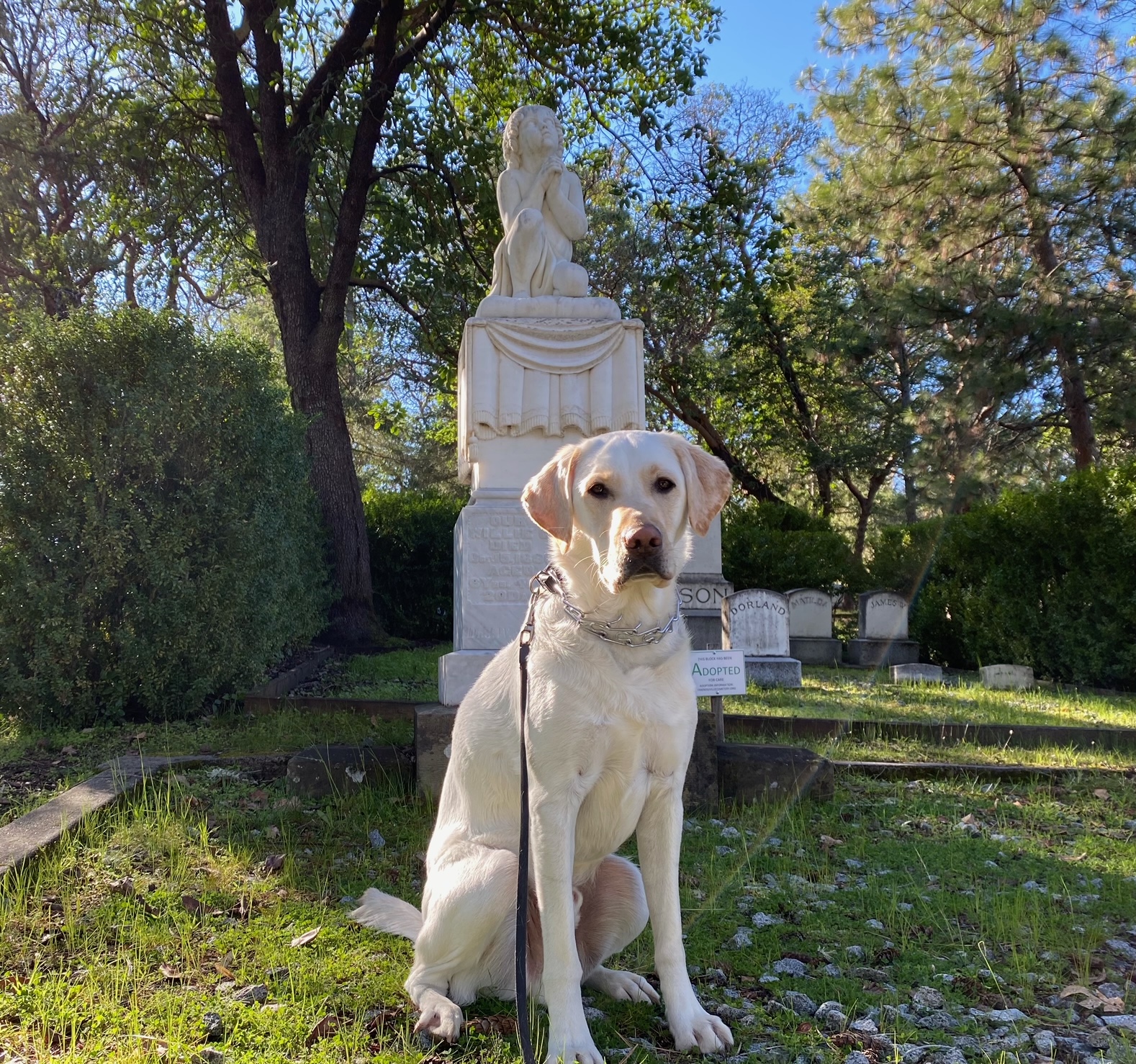 |
Regina Dorland Headstone
Mozzie, our playful yellow Lab, is back this week to wrap up our Women’s History Month series.
He’s visiting the Robinson block in Jacksonville’s Pioneer Cemetery and the grave of Regina Dorland Robinson. The angel behind Mozzie is a copy of a famous Italian statue by Donatelli, carved by local stonemason J.C. Whipp. It was a tribute to Dorland’s older brother and sister, Willie and Leah, who died in the diphtheria epidemic of 1890. Dorland was born shortly after her siblings’ deaths.
Dorland became a talented impressionist artist. When she was 14, her oils and drawings were already taking first prize at the County Fair. Dorland’s parents nourished her artistic abilities with private lessons in Portland, Philadelphia, and San Francisco, at the same time sheltering her from interactions with the outside world. Her work began appearing in exhibitions up and down the West Coast with art critics deeming her a “genius.”
Despite her parents’ close supervision, Dorland somehow encountered C.E. Pierson, a salesman for the Yale Lock Company. In October 1916, a 24-year-old Dorland eloped with him. However, Dorland was naïve and unprepared for marriage (and possibly the world). Within weeks she had returned home. Within six months of her marriage, she committed suicide.
During her brief life, Dorland produced an exceptional body of work. Many of her paintings are in the collection of the Southern Oregon Historical Society.
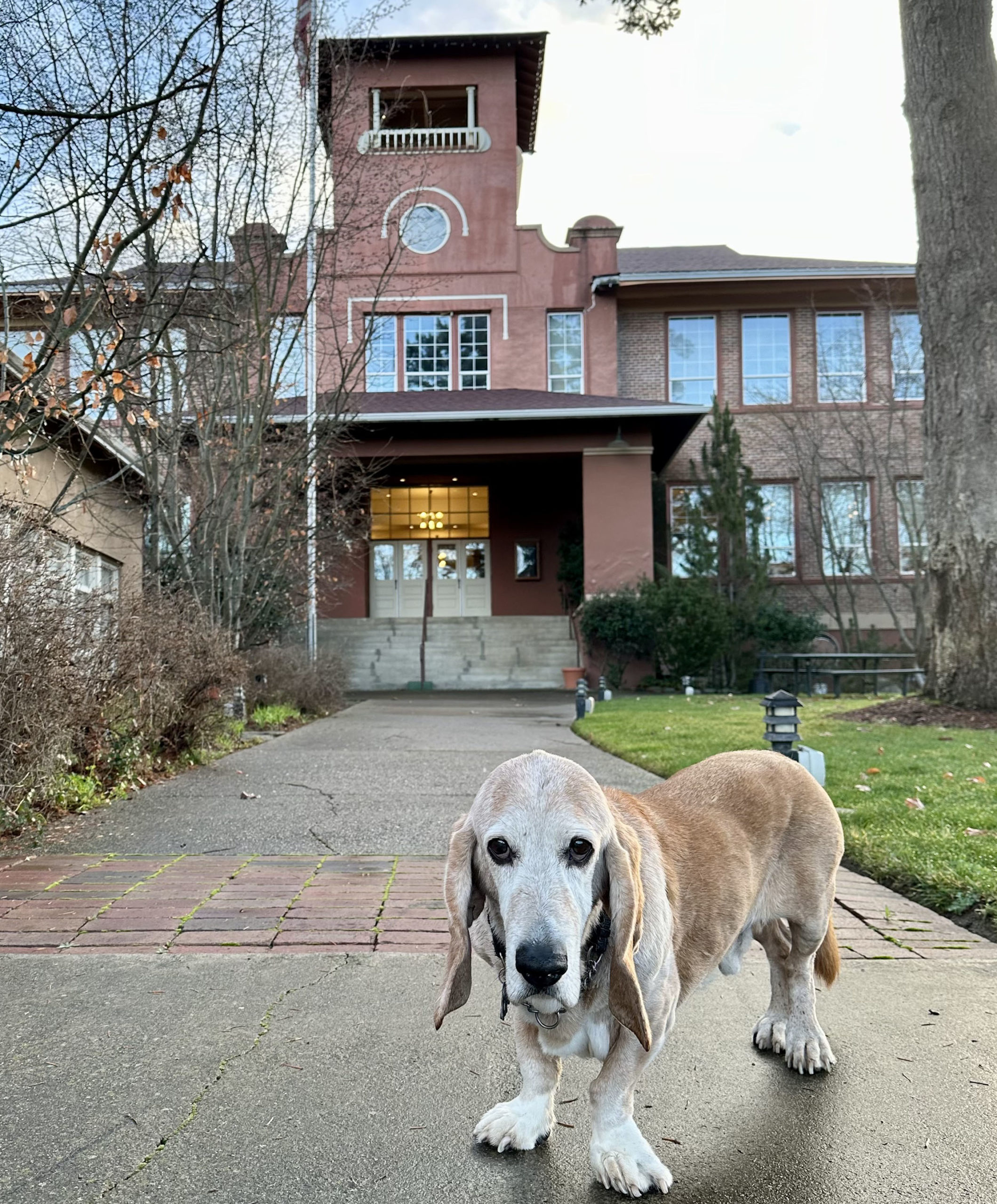 |
Bigham Knoll
Trevor, our favorite “bagel” (Bassett-Beagle) is visiting Bigham Knoll, the original 7-acre campus that was once home to Jackson County School District #1.
In 1867, when the County’s first public school was deemed inadequate, the school district directors acquired this property and converted an existing two room house into a school building until local builders could erect a new 2-story frame and “weather boarded” schoolhouse. A year later, increased school enrollment necessitated enlargement of the new building and an addition was completed “sufficiently large to accommodate all the pupils of the district.” This building served 3 generations of students for 36 years until it was destroyed by fire in January 1903.
Within a month the School Board made plans for a fireproof brick building and a new 5-room school building was erected. However, the best laid plans…. Four years later this “fireproof” brick structure was totally destroyed by fire. Even though the building was not fully paid for, voters quickly approved a bond measure for another school.
The new fireproof brick building, completed in 1908, was acclaimed one of the best-appointed schoolhouses in the state with 6 classrooms, a large assembly room with a large stage fitted with electric footlights, and a steam heating plant. A large gymnasium building, additional classrooms, and other outbuildings were added between 1924 and 1953.
But by the 1950s the structure had safety issues, and in 1959 the high school was closed, and the second floor of the building blocked off. One year later, the cupola and bell tower were removed. After a new elementary school was constructed in 1983, private schools occupied this structure through 2007 when the property was acquired by the Ashland family for their corporate headquarters and lovingly restored to its original glory.
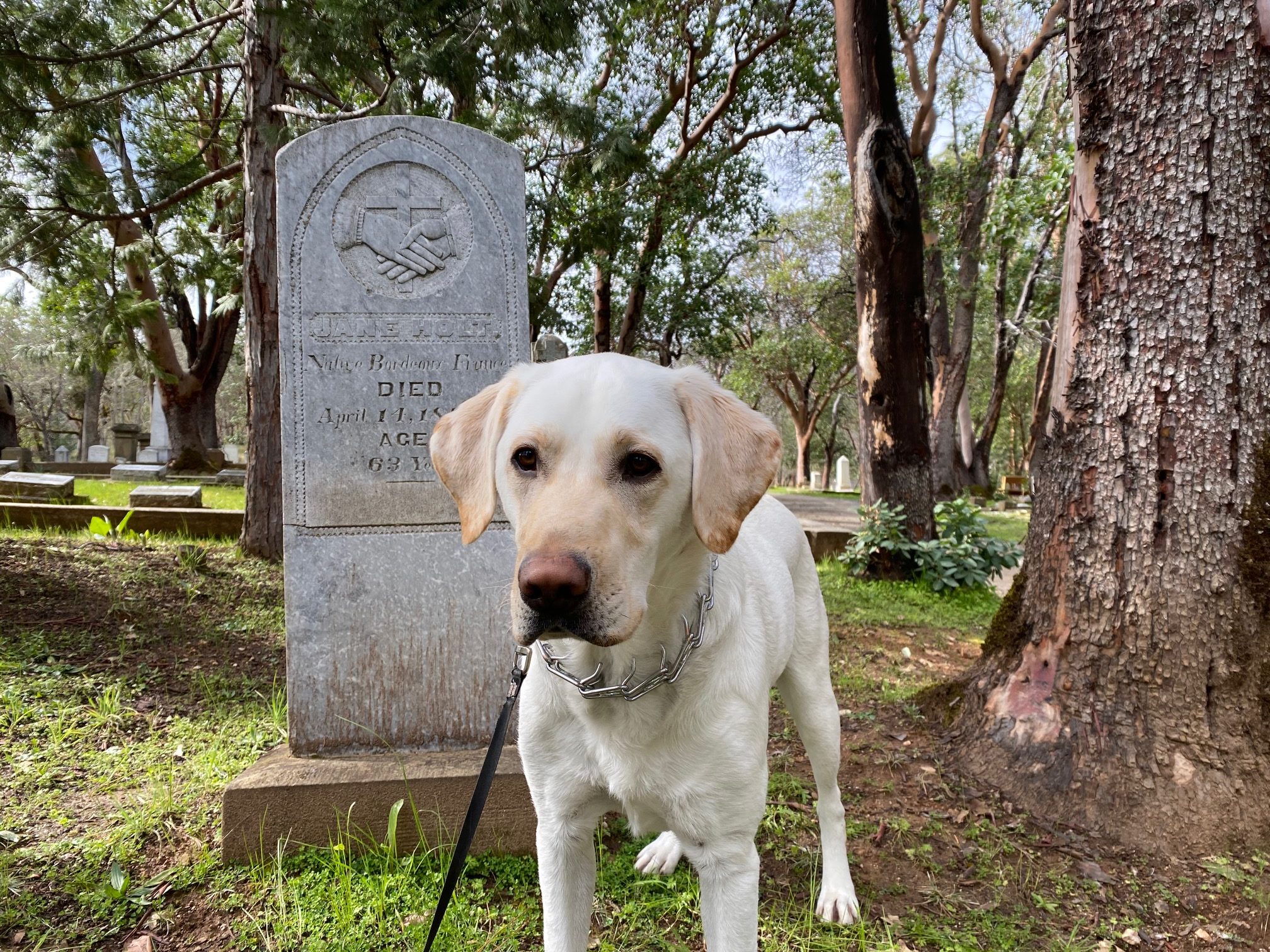 |
Jane Holt Headstone
Mozzie, our playful yellow Lab tour guide, is helping us celebrate Women’s History month with a visit to Jacksonville’s pioneer cemetery and the grave of Jane Holt. This small, relatively plain, headstone in the Catholic section is an ironic “grand finale” for Madame Jeanne DeRoboam Laugier Guilfoyle Holt, a larger-than-life character in 19th Century Jacksonville.
Claiming an aristocratic French heritage, Jeanne had arrived in Jacksonville by the late 1850s with Charles Laugier, probably her Italian common-law husband. Sometime before 1858, they opened the Franco-American Hotel on the southeast corner of S. Oregon and Main streets, now the site of the Jacksonville Inn’s cottages. It soon became the town’s leading hotel and stage stop, noted for its “table d’hôte.” Light biscuits and tender steaks undoubtedly attracted a regular clientele.
Sometime after 1860, DeRoboam and Laugier parted ways, and in 1865 she married Irishman John Guilfoyle, 12 years her junior. When Guilfoyle died 7 years later, she married brick mason George Holt, supposedly for the sole purpose of realizing her dream of a grand brick hotel.
Holt built Jeanne the U.S. Hotel, the “grandest hotel on the West Coast” on property she had purchased at the corner of California and 3rd streets. By September 1880, sufficient rooms had been finished to accommodate President Rutherford B. Hayes and his party for a night’s stay. They enjoyed her famous hospitality, but balked at the bill, twice that of San Francisco hotels.
Gen. W.T. Sherman, a member of the party, allegedly protested, “We don’t want to buy your hotel.” Madame supposedly responded, “Well, I thought the President could afford to pay a little more than the common people.”
Jeanne operated the U.S. Hotel for the next four years until her death in 1884. Unquestionably an astute businesswoman, she was not popular with Jacksonville women. It may have been the 3 “husbands,” her alleged “aristocratic birth,” her successful career, or their husbands’ preference for her “table d’hote.” She also reputedly responded to the Temperance movement with “A glass of wine and small white lies doth not a harlot make.”
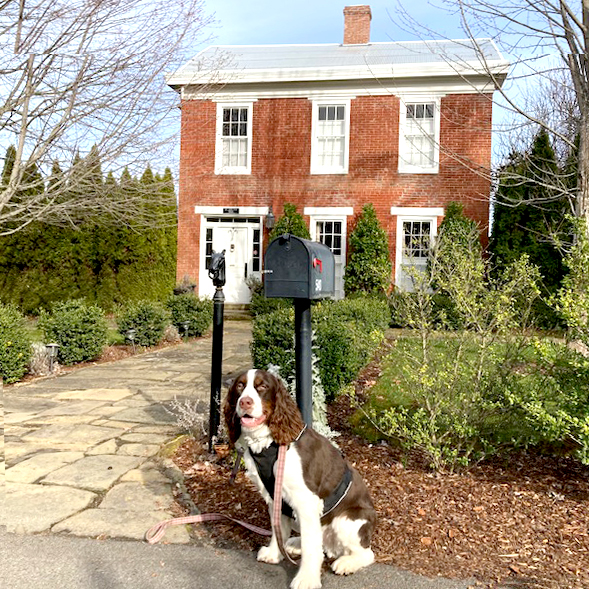 |
Bilger House
Jaxon has found his way to 540 Blackstone Alley where he’s visiting the 1863 Bilger House. Successful Jacksonville tin merchant and civic leader, John Bilger, built this home 2 years after he married fellow German Amanda Scheck.
Bilger had arrived in Jacksonville by 1856. That same year, he and his partner, John Love, purchased a “tin shop” on California Street and within a year were actively engaged in selling “tin plate and sheet iron works” to the public. In 1863, Jacksonville’s newly-formed government elected Bilger the town’s Street Commissioner.
After Bilger’s partner, John Love, died of tuberculosis in 1867, Bilger expanded into hardware, advertising “goods not only for the stove and tinware trade, but all kinds of hardware and farming implements.” By 1868, Bilger’s success in business earned him an annual income of $1,000, making him the town’s wealthiest resident.
When Bilger died in the 1877 cholera epidemic, his wife Amanda continued to operate the business to support their 8 children. She initially ran the business as “Pioneer Hardware.” By the 1880s she had partnered with Aaron Maegly, and by 1884, Bilger and Maegly was considered one of the 3 leading manufacturers of agricultural machinery and implements in Jacksonville.
The Bilger House is one of Jacksonville’s few early brick residential structures and the only one in the Federalist architectural style.
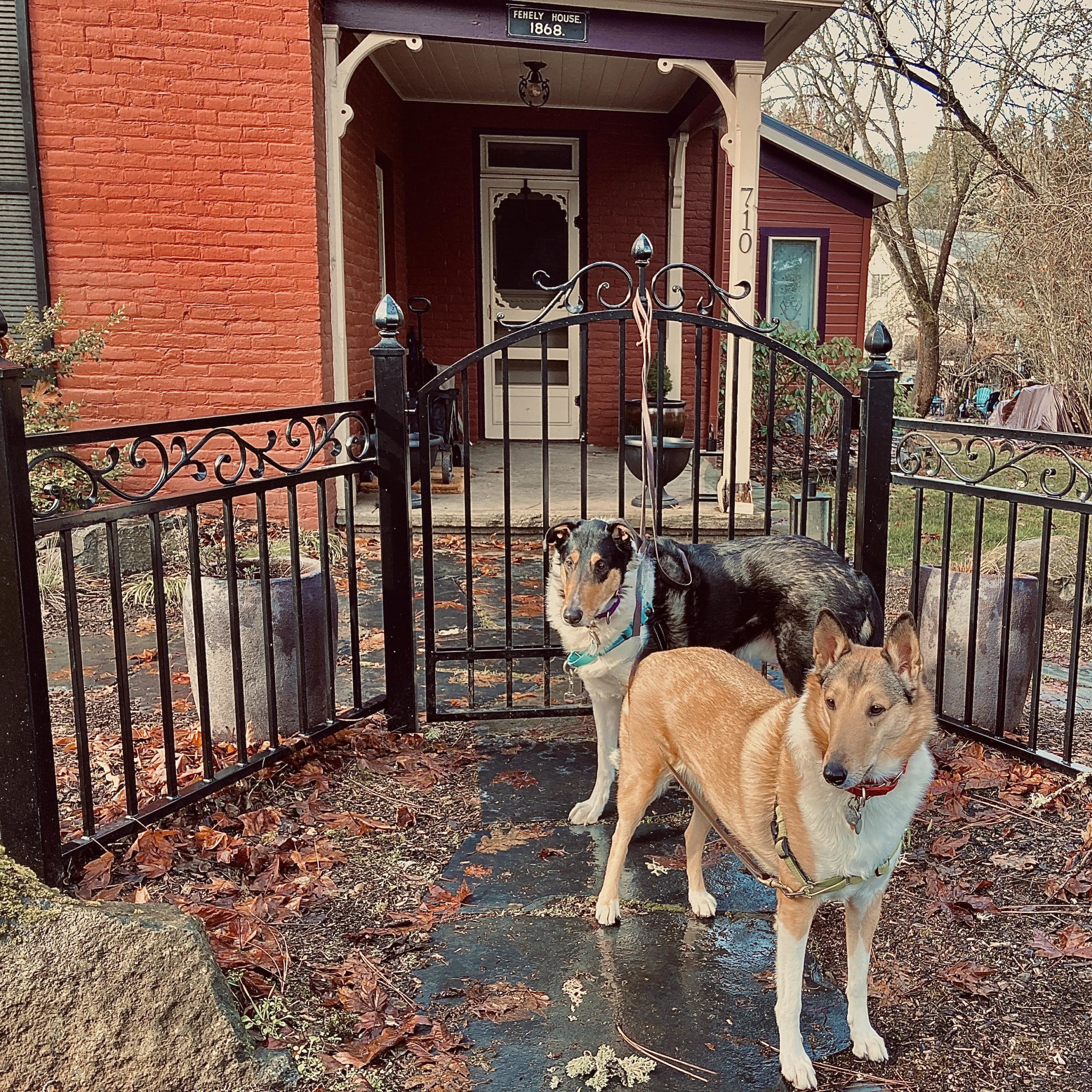 |
Fehely House
Ariel and Caliban are admiring the bricks at Jacksonville’s Fehely House at 710 South 3rd Street.
When 34-year-old Sarah Jane Fehely died from typhoid in 1871, she left her husband Patrick with 7 children to raise. Following the Fehely’s marriage 20 years earlier, the birthplaces of their children traced their travels in pursuit of gold from Wisconsin to Jacksonville. “Fehely Gulch” near Lewiston in Northern California marks one of their stops.
The Fehelys arrived in Jacksonville prior to the 1860 census, which shows Patrick as a “farmer.” During the next decade he appears to have periodically left his wife and children, venturing to gold fields in Idaho and Montana and engaging in farming near Seattle. He had returned to Jacksonville prior to Sarah Jane’s death, and 2 years later built this 2-story brick home for his family.
The 1870 census shows Patrick employed as a “brick maker.” He is credited with constructing many of Jacksonville’s early brick commercial buildings, possibly in partnership with fellow Irishman P.J. Ryan. Fehely’s brickyard was reportedly located behind his house on Daisy Creek and considerable amounts of brick have been found in the area.
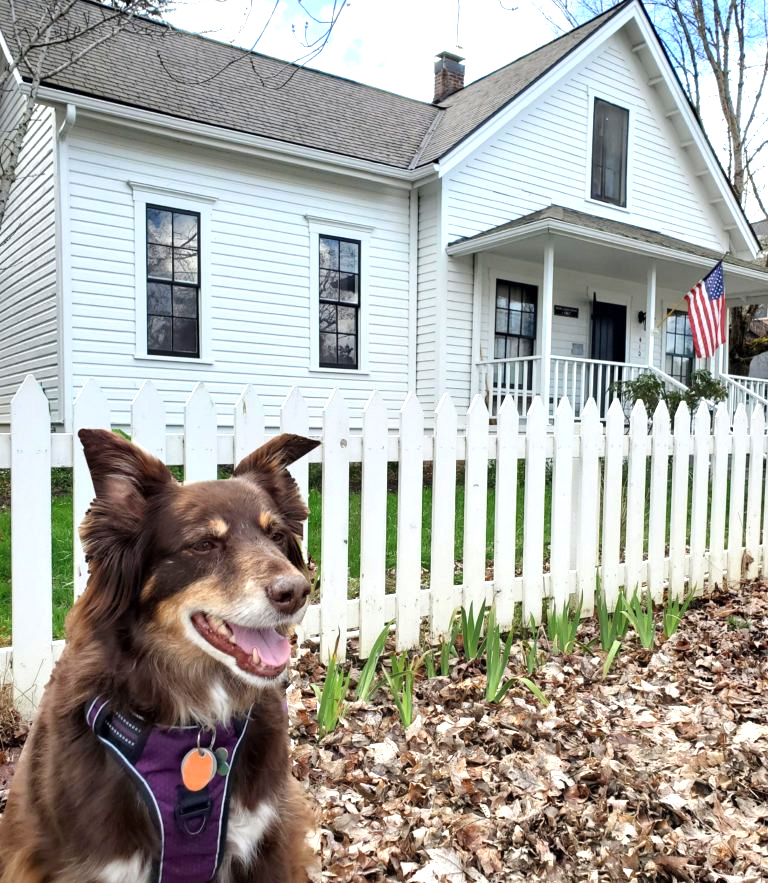 |
Henry Judge House
Gracie is visiting the house at 410 East D Street in Jacksonville. Although sometimes known as the “Sheriff’s House,” it was built for Henry Judge in the mid-1860s, shortly after he married Anna O’Grady. Judge, one of Jacksonville’s earliest residents and a pioneer in the harness and saddlery business in the West, had arrived from San Francisco in the mid-1850s, and on several occasions returned there for 3 or more years at a time. At various times, Judge was also in partnership with Jeremiah Nunan, who later married Anna’s sister, Delia O’Grady. Judge became one of Jacksonville’s wealthiest residents, and on at least 2 occasions served as a Trustee for the City.
In 1868, Judge sold the house to Dr. Franklin Grube, a prominent surgeon who identified the presence of smallpox in Jacksonville that same year. The disease reached epidemic proportions and Grube himself succumbed one year after purchasing the house.
The next resident was James A. Wilson who operated the prosperous Union Livery Stable at the corner of California and 4th streets. His granddaughter, Grace Wilson, was the second wife of Frank C. Clark, the prominent architect who designed some of the Rogue Valley’s most noteworthy residential, commercial, and public edifices between 1910 and 1945. The Clarks subsequently occupied the house for a number of years.
And in 1979, it was one of the staff buildings occupied by the Southern Oregon Historical Society when they were headquartered in Jacksonville.
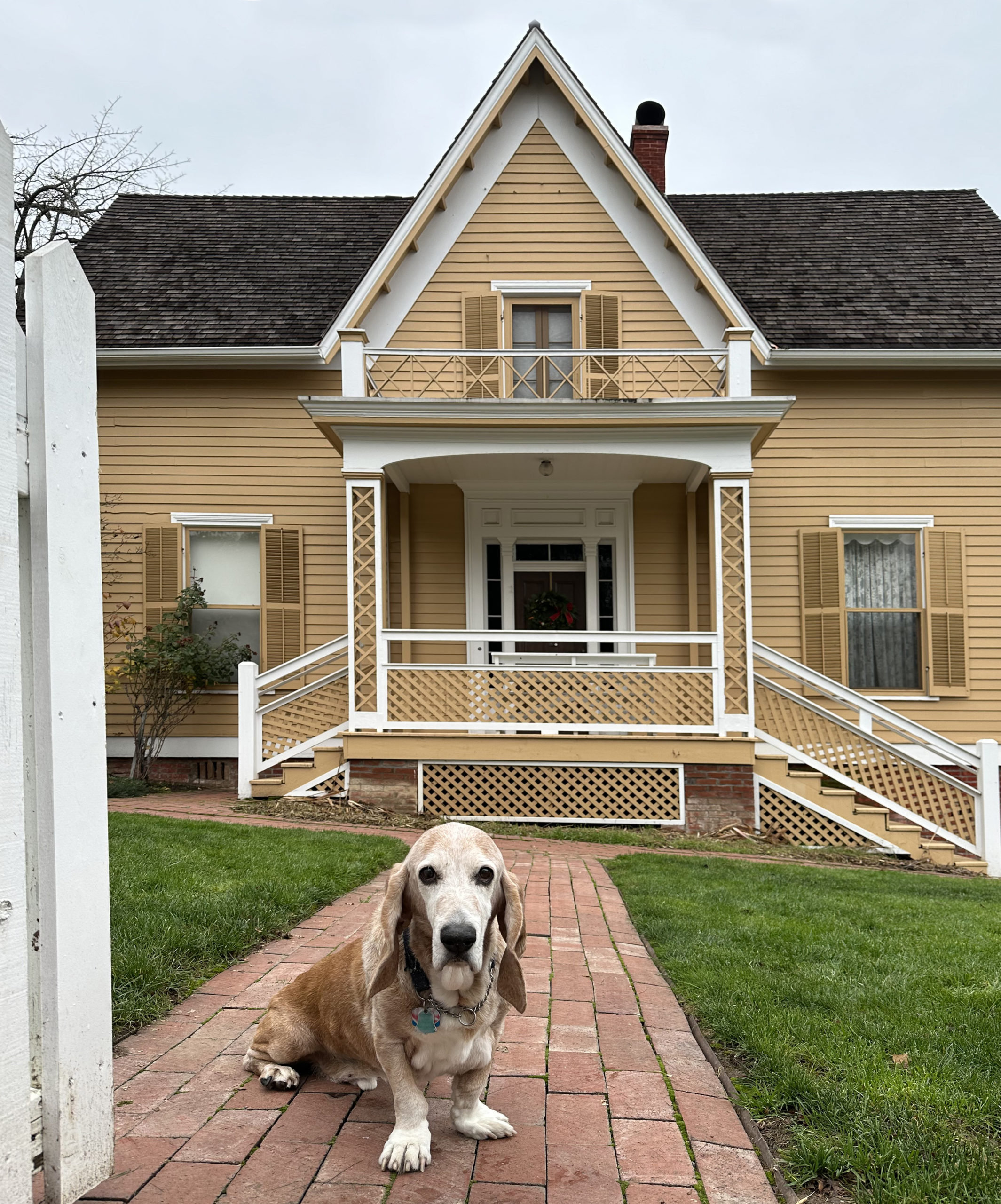 |
Beekman House
Trevor is visiting one of Jacksonville’s premiere Victorian homes. In July 1870, Cornelius C. Beekman purchased 3 lots at what is now the corner of Jacksonville’s East California and Laurelwood streets and commissioned this modest Carpenter Gothic style home for his family. The house, owned and occupied by only the one family and still completely furnished with family artifacts, does not reflect the family’s social status. The Beekmans were the most prominent and probably the wealthiest family in Jacksonville.
From a humble beginning as an express rider carrying mail, packages, and gold over the Siskiyous to Yreka, Beekman built a business empire of banking, insurance, mining, and real estate interests. He also served as Mayor of Jacksonville, Republican candidate for Governor of Oregon, Worshipful Master of the Masonic Lodge, and Regent of the University of Oregon.
Beekman passed away in 1915, his wife Julia in 1931. On the 3rd Saturday of each month through May, their children, Ben and Carrie, will emerge from the pages of history and be in town to close up their family home with the help of family members and friends. This can be your chance to step back to 1932 Jacksonville along with Trevor and visit with them as they go through closets and cupboards while commenting on Depression Era Jacksonville and growing up in the late 1800s. Learn how to spend an hour time traveling at https://historicjacksonville.org/1932-living-history/
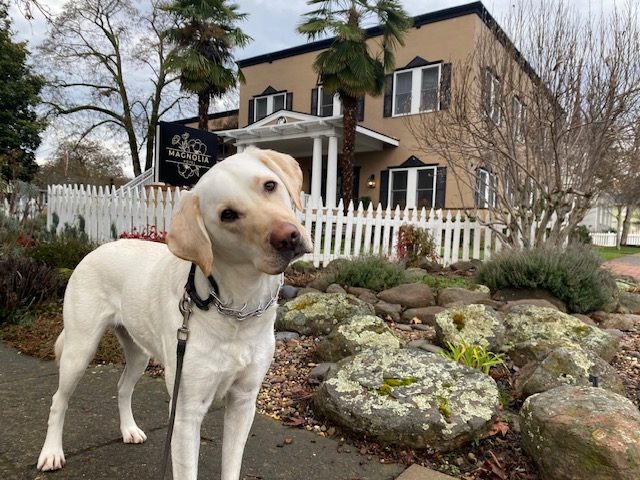 |
Magnolia Hotel
Mozzie, our playful yellow Lab tour guide, looks like he’s thinking about checking into the Magnolia Hotel.
This Spanish Revival style building at 245 North 5th Street in Jacksonville was built in the early 1900s as a sanitarium and health spa. It was part of the “Wellville” movement pioneered by the Kellogg brothers. This approach to medicine advocated holistic treatments and vegetarianism, and such sanitariums typically focused on nutrition, enemas, and exercise. John Harvey Kellogg also created the “health food,” Kellogg’s Corn Flakes in hopes that it would reduce what he considered unwelcome sexual impulses.
In the 1930s, the County began placing most of its poor in buildings in Jacksonville because property values were some of the lowest in the County and there were plenty of potential caretakers among the people looking for work. Mitchell’s was one of these “poor houses,” but it was as much hospital as sanitarium. Apparently, it was originally known as the Rogue River Sanitarium, but by the 1950s had been renamed the Mitchell Sanitarium. Today it houses one of Jacksonville’s popular bed and breakfast establishments.
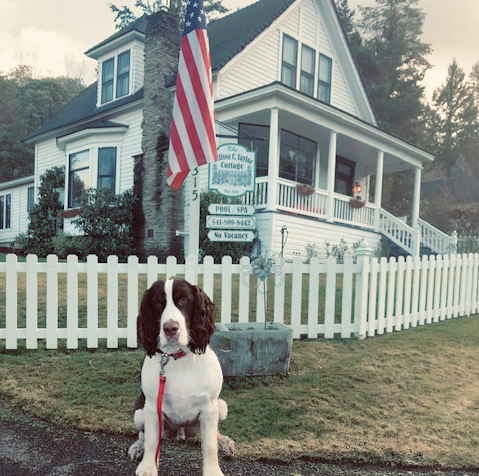 |
Melissa Taylor House
Jaxon, our English Spring Spaniel, is sniffing out the Melissa Taylor House at 255 South 5th Street.
Melissa Rogers Taylor had the Queen Anne style cottage built around 1910 after the death of her husband, Sam. She had married Samuel Taylor in 1872 although she was 21 years his junior, having been born only 2 years before Sam came across the Oregon Trail in 1851. She outlived him by 34 years.
Samuel Taylor had moved to Jacksonville in 1852 after the discovery of gold. He mined off and on for the next 30 years, spending 2 years as Superintendent of the Steam Boat placer mine. In the late 1850s, Sam served 2 terms as Deputy Sheriff of Jackson County. He is also said to be one of the first stage drivers in Oregon, and later operated a freight line between Jacksonville and surrounding communities until his death in 1908.
Prior to Sam’s death, it appears that the couple resided in a dwelling at the southwest corner of California and 4th streets. Melissa apparently had an entrepreneurial spirit as well since by 1890, she had converted the dwelling into a boarding house, expanding it over the next 20 years. Although she sold it after her husband’s death, a 1930s Sanborn map still shows it as the Taylor House apartments.
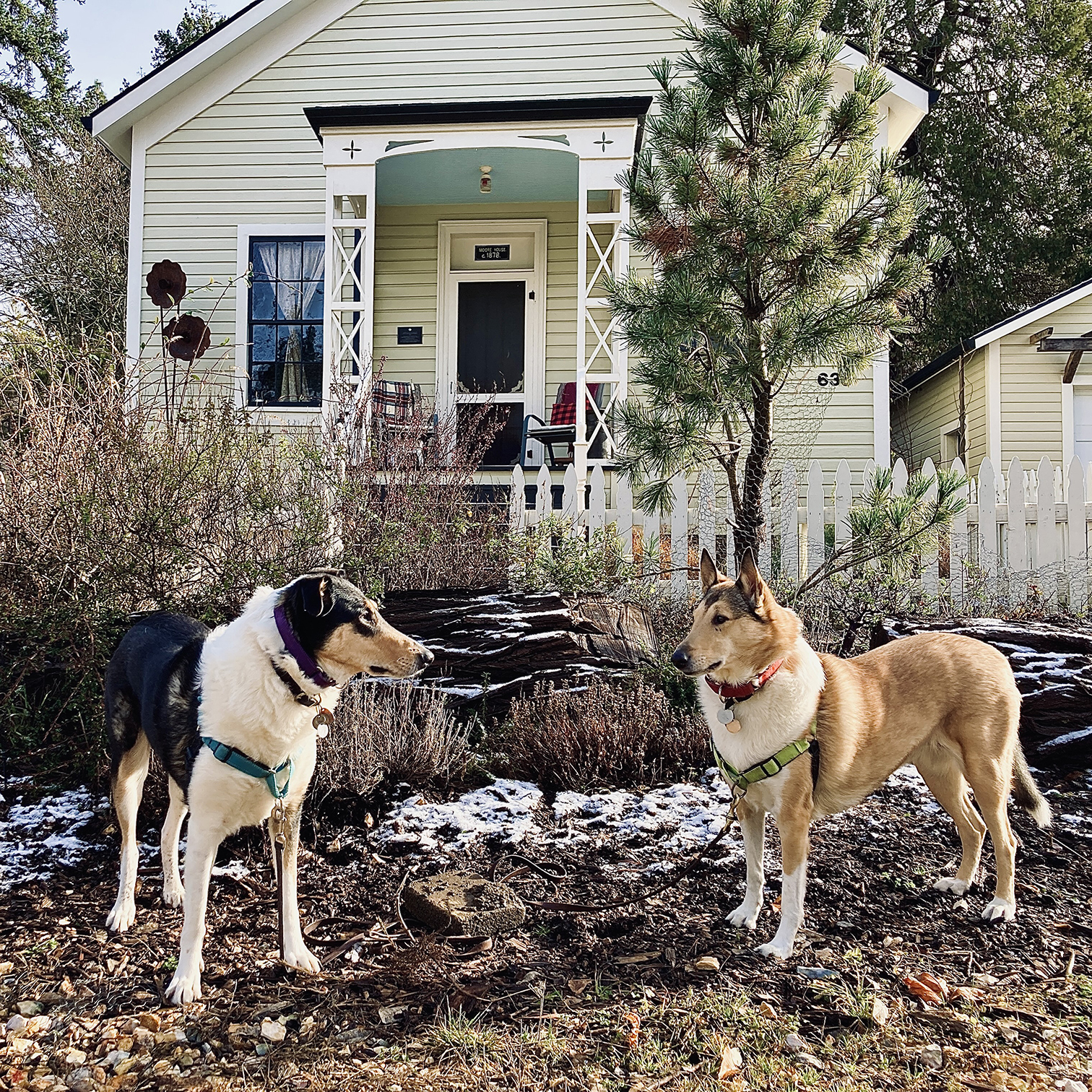 |
Cantrall House
Smooth Collies Caliban and Arial caught the last of the town’s recent snow while visiting the Moore-Cantrall house at 635 South 3rd Street.
This one-story wood frame house was built in 1878 for William Moore. Natives of Pennsylvania, Moore and his wife Rebecca had arrived in Jacksonville 3 years earlier. His occupation is listed in early censuses as “laborer.”
In 1899, the Moores sold the house to Sarah Cantrall. Sarah had moved to town 9 years earlier after the death of her husband John. John Cantrall had come to Southern Oregon in the late 1850s and mined Sterling Creek during the boom years. In 1865, the Cantrall family left Sterling Creek and took up an 80-acre land claim across the Applegate River from Uniontown. Cantrall continued to mine and farm for the next 25 years, also purchasing adjoining land.
From pioneer days to the present, a rock rimmed pool on the Cantrall’s Applegate River property was a natural swimming hole. In 1960 the Bureau of Land Management built a bridge across the river just above the swimming hole to access some of its forest tracts. The bridge made it possible for the Jackson County Parks Department to purchase 45 acres and develop a large park, now known as the popular Cantrall-Buckley Park in honor of the Cantralls and their neighbors.
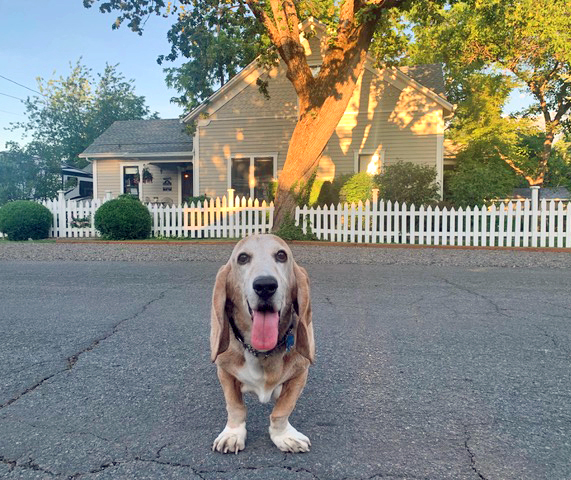 |
Kahler Family Home
Trevor is visiting the house known as the “Kahler Family Home” at the northeast corner of 6th and D streets in Jacksonville.
Robert Kahler acquired the entire block in 1879 then sold this portion to his father 2 years later. His parents were one of the first pioneering families to settle in the Rogue Valley.
Three of the Kahler boys did quite well. Robert, a druggist, dispensed drugs, books, and stationery from his building on California Street. George was a practicing surgeon and physician. Charles Wesley Kahler was a prominent Jacksonville attorney. C.W. owned this building by the late 1890s.
This house was either constructed by another family member after C.W.’s death in 1904 or the original house was redesigned from its original Classical Revival style to incorporate its current Queen Anne influences.
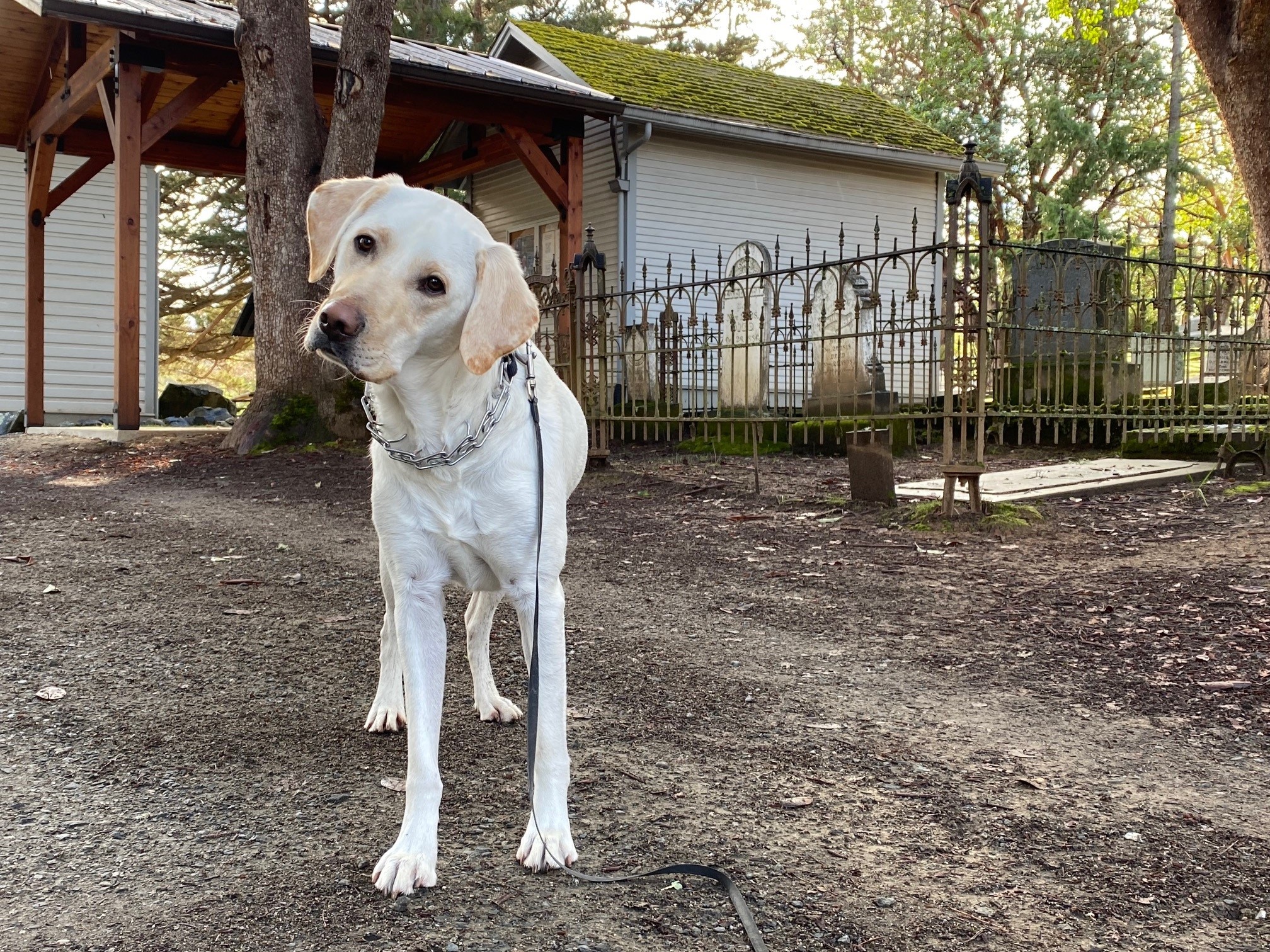 |
Duncan Cemetery Plot
Mozzie appears to be pondering the gravesite of Judge Legrand Joseph Colville Duncan next to the cemetery’s Interpretive Center. Duncan was the original owner of what we know as the Judge Hanna House on Jacksonville’s South 1st Street.
Hanna was a lawyer, district attorney, and circuit court judge. Duncan was today’s equivalent of County Commissioner, “Judge” being the title for the position at the time.
Duncan was elected a Jackson County Commissioner in 1866, declining renomination when his term expired 4 years later, but agreeing to fill an 1871 vacancy. He had previously been elected Jackson County Sheriff in 1858 and reelected in 1860. He had also been a member of the 1857 convention that drafted Oregon’s Constitution.
Born in Tennessee and having only an 8th grade education, Duncan can be considered an “American success story.” After some 20 years of teaching school and trying his hand at mining, he found his niche in Jacksonville. And the rest is history!
 |
Biede House
Jaxon is visiting the Otto Biede house located at 360 S. Oregon Street. It was probably constructed around 1893, for the Biede family, although it may have been a “remodeled” version of an 1880s house. Otto and Helene Marie Biede were both born in Hanover, Germany in 1858. They immigrated to the U.S. in 1884, arriving in Jacksonville in 1890 where Otto established a hardware and tinsmith business and Marie, a proficient pianist, taught piano lessons.
An earlier structure existed on the lot no later than 1864. Occupied by German-born William Kreuzer, grocer and owner of the City Bakery and Saloon, it was also reportedly used as the “German school” for children of Jacksonville’s German-speaking population—about 1/3 of the town’s early settlers.
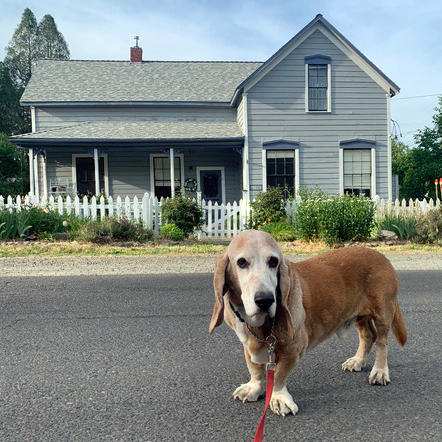 |
Karewski House
Trevor is visiting the house at the northwestcorner of 6th and D streets which was built as a rental about 1881 by Gustav Karewski and Aaron Maegly.
Karewski, a native of Prussia, had arrived in Jackson County by 1856. He became a prosperous dry goods merchant and miner. When farming became more important than mining, Karewski opened Karewski’s Agricultural Implements, dealing in plows, graders, harvesting machines, and steam-powered tractors.
Aaron Maegly arrived in Jacksonville around 1880. He initially worked as chief clerk in Karewski’s hardware store. But by 1884, he had gone into competition, becoming a partner in Bilger and Maegly, one of the 3 largest local manufacturers of agricultural machinery and implements. Two years later Maegly had established his own business, A.H. Maegly and Company, dealing in stoves, tinware, hardware, and agricultural implements.
In 1885 Maegly married Cecelia Levy, Karewski’s stepdaughter from his marriage with Joanna Levy. The young couple occupied this house at the corner of 6th and D streets. After Karewski’s death in 1890, the Maeglys moved to Portland where Aaron became a very successful real estate and mortgage broker. Their mansion in Portland’s Arlington Heights is on the National Historic Landmark Register.
Cecelia retained ownership of the Jacksonville property until 1931. It continues to be a private residence.
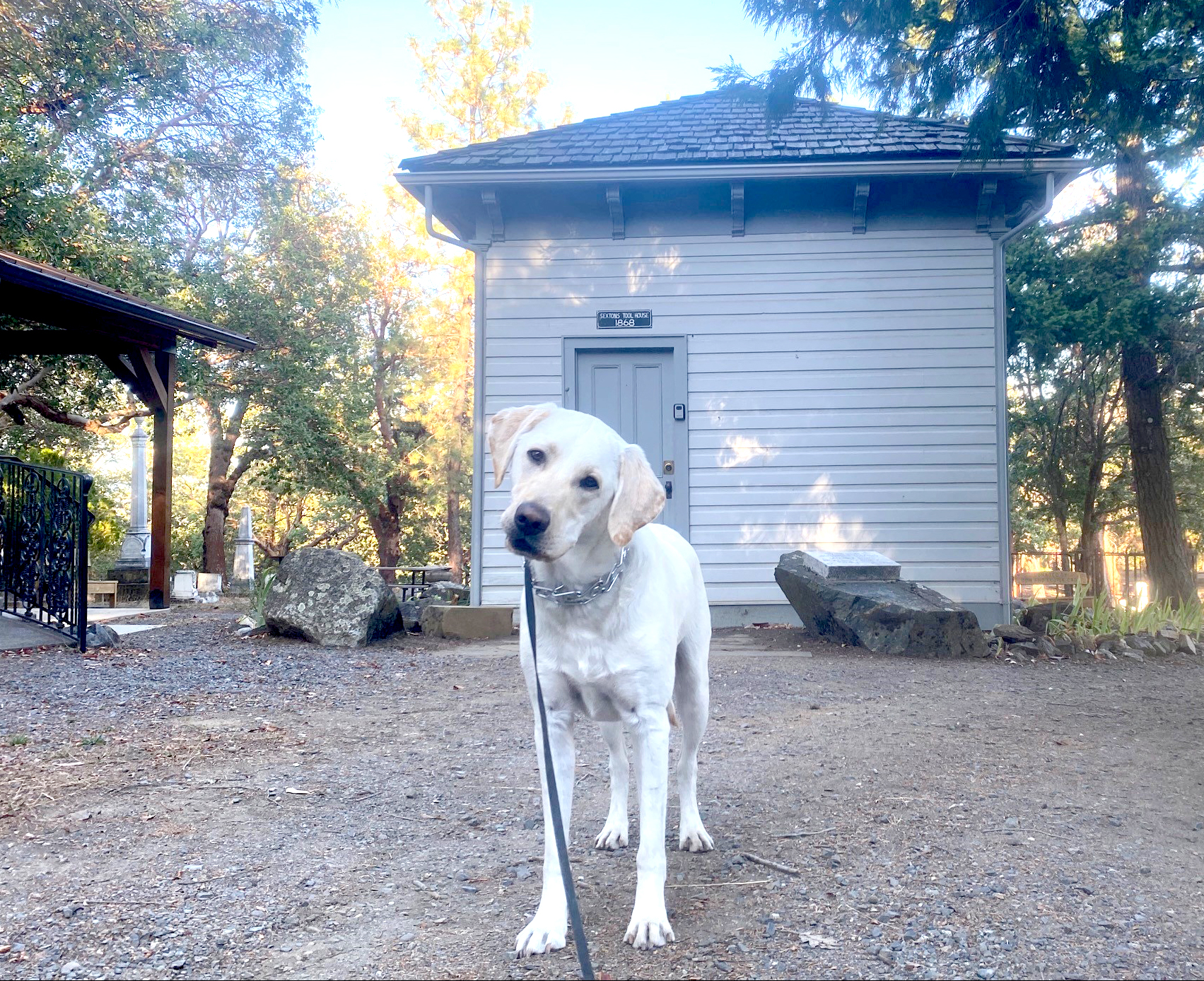 |
Sexton’s Tool House
The Cemetery itself had been dedicated in 1860, although the first burial took place in 1859. In 1863 R. Sergeant Dunlap was appointed the first cemetery sexton. He served in that capacity for many years, maintaining the grounds, selling plots, digging graves, and keeping the cemetery records. In 1880, after nearly 25 years of service, the “Sentinel” commended him for taking “great pains in keeping the grounds in good order and otherwise improving them.” The newspaper also noted that Dunlap “kept a list of all the burials for the past twenty-one years, cause of death, etc., which list if published would constitute an interesting pate in the history of Jacksonville and Rogue River Valley.”
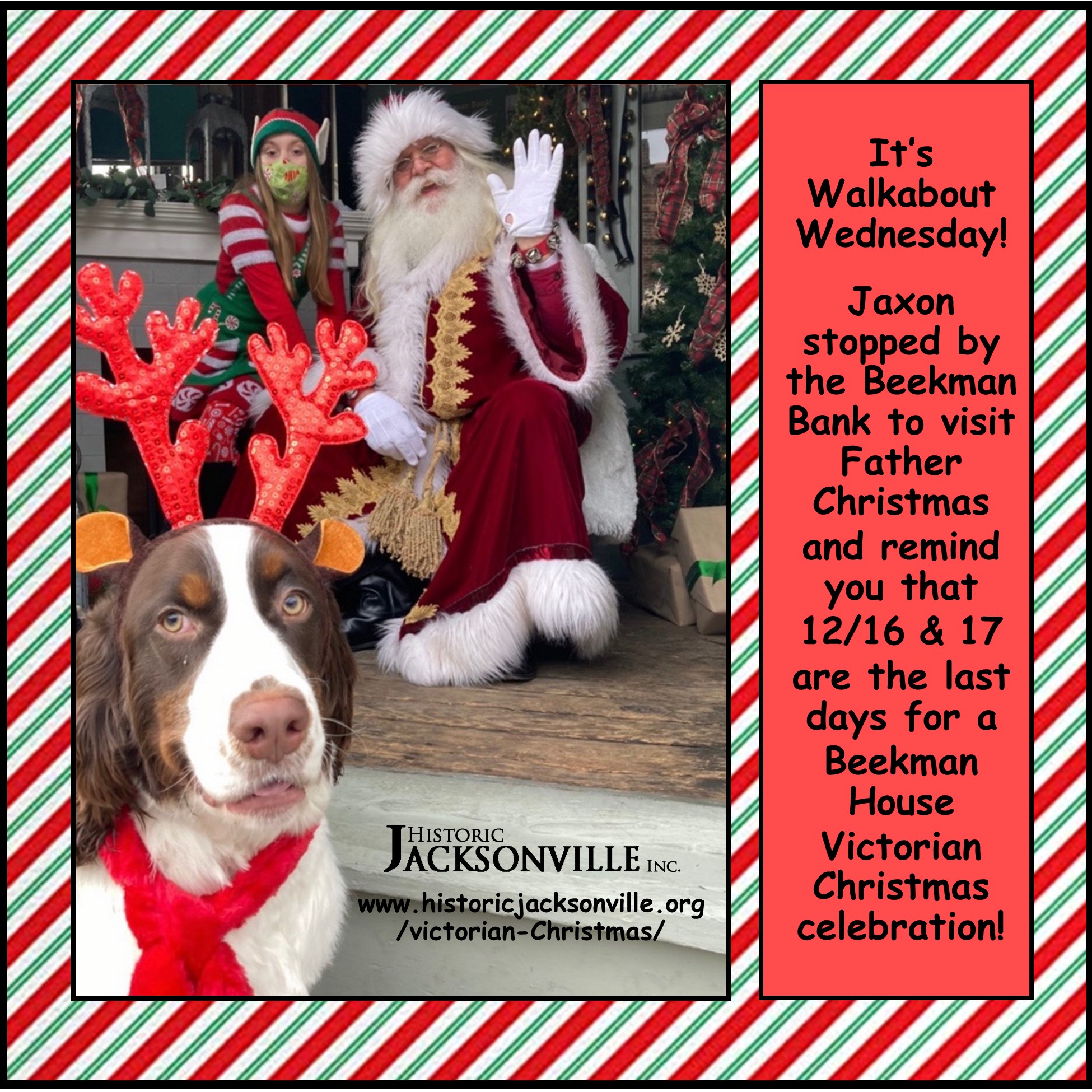 |
Beekman Bank
Today Jaxon is visiting the 1863 Beekman Bank at the corner of California and North 3rd streets. It’s the oldest financial institution in the Pacific Northwest, beginning as a gold dust office in 1856. Since the Bank has been closed for the holidays, Father Christmas and his elves have been borrowing the Bank foyer when they have been visiting Jacksonville on Victorian Christmas weekends. It’s provided an opportunity for Father Christmas to hear what local children have on their wish lists and it looks like Jaxon may have shared his wishes as well. Judging from his head gear, Jaxon may have wished to join Father Christmas’ reindeer team!
You can learn how reindeer replaced Father Christmas’ flying horse on one of Historic Jacksonville’s last Beekman House Victorian Christmas tours this Saturday and Sunday, December 16 and 17. The 1870s home of Jacksonville’s richest pioneer family is decorated for a 19th Century Christmas celebration, and costumed docents will be sharing the origins of our holiday traditions during 1-hour tours beginning every 20 minutes between 12n and 3pm. Admission is $10 for adults; $5 for children 12 and under. You’ll find tickets and information at https://www.historicjacksonville.org/victorian-christmas/
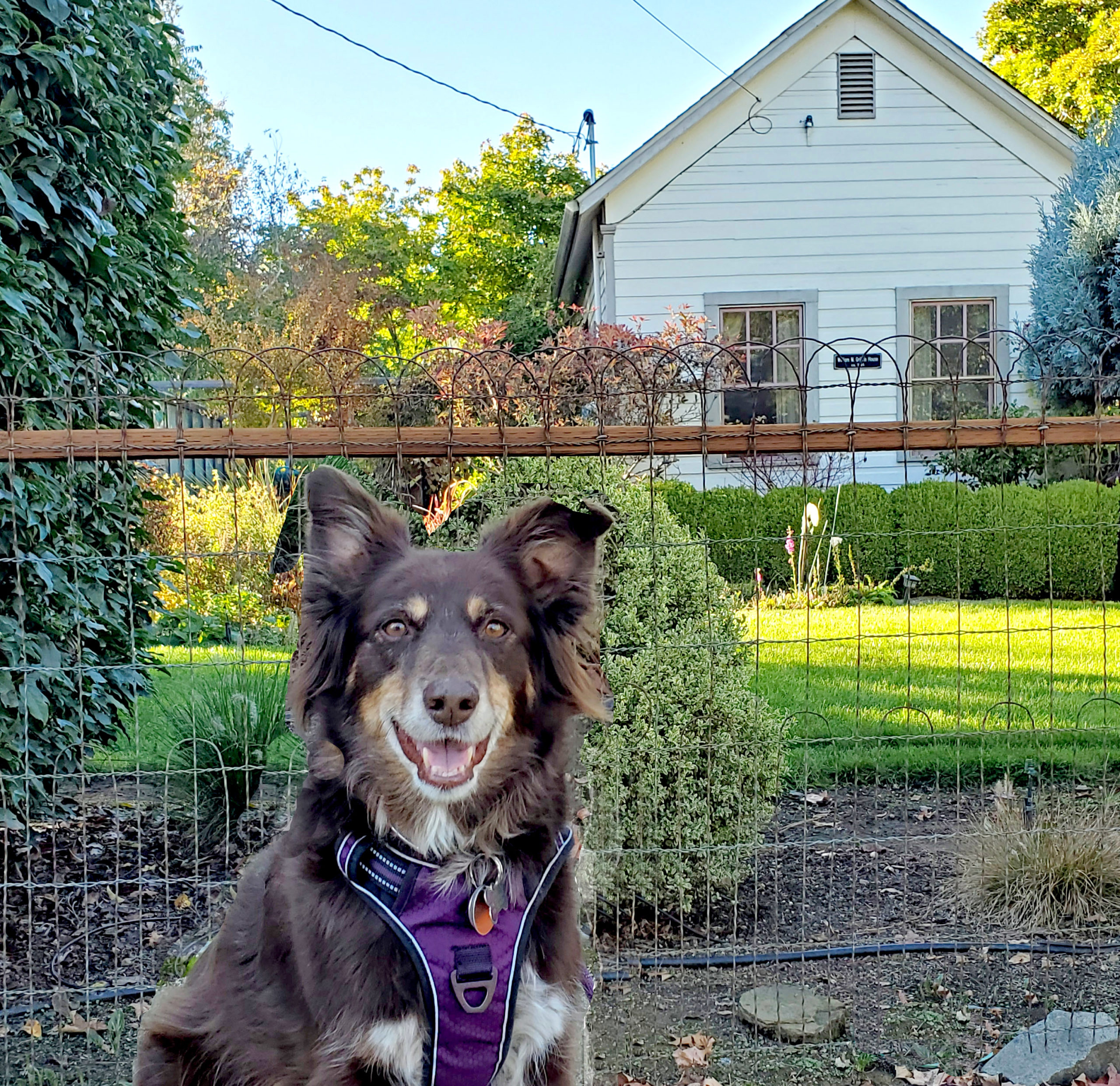 |
William Griffen House
Today Gracie is visiting the William Griffen house at 410 South 3rd Street in Jacksonville. Are you familiar with Griffen Creek? Well, this is the same Griffen family. In 1852 Burrell Griffin had brought his family from Kentucky to the Rogue Valley where he took out a donation land claim in the area of the creek that bears his name.
William was his eldest son. William initially farmed as well, then became a “wagon trader.” In 1866, this parcel of land and core structure were deeded to him by the town trustees. Since transactions often postdated occupancy and since early photographs and maps did not include this sector of the town, it’s thought that the north portion of the house dates from at least 1864.
In 1871, Patrick McMahon purchased the property for $503. A native of Ireland, McMahon had apparently been a resident of Jacksonville since his early childhood. He added the south portion of the house for his growing family.
McMahon was apparently quite successful in various business pursuits. He owned and built rental property, was a mail contractor, and operated the Jacksonville-Crescent City Stage Line. At the time of his death in 1886, the “Oregon Sentinel” described him as “a man of great energy” and one of Jacksonville’s “most industrious and enterprising citizens.” It also reported that he “left his family in affluent circumstances.”
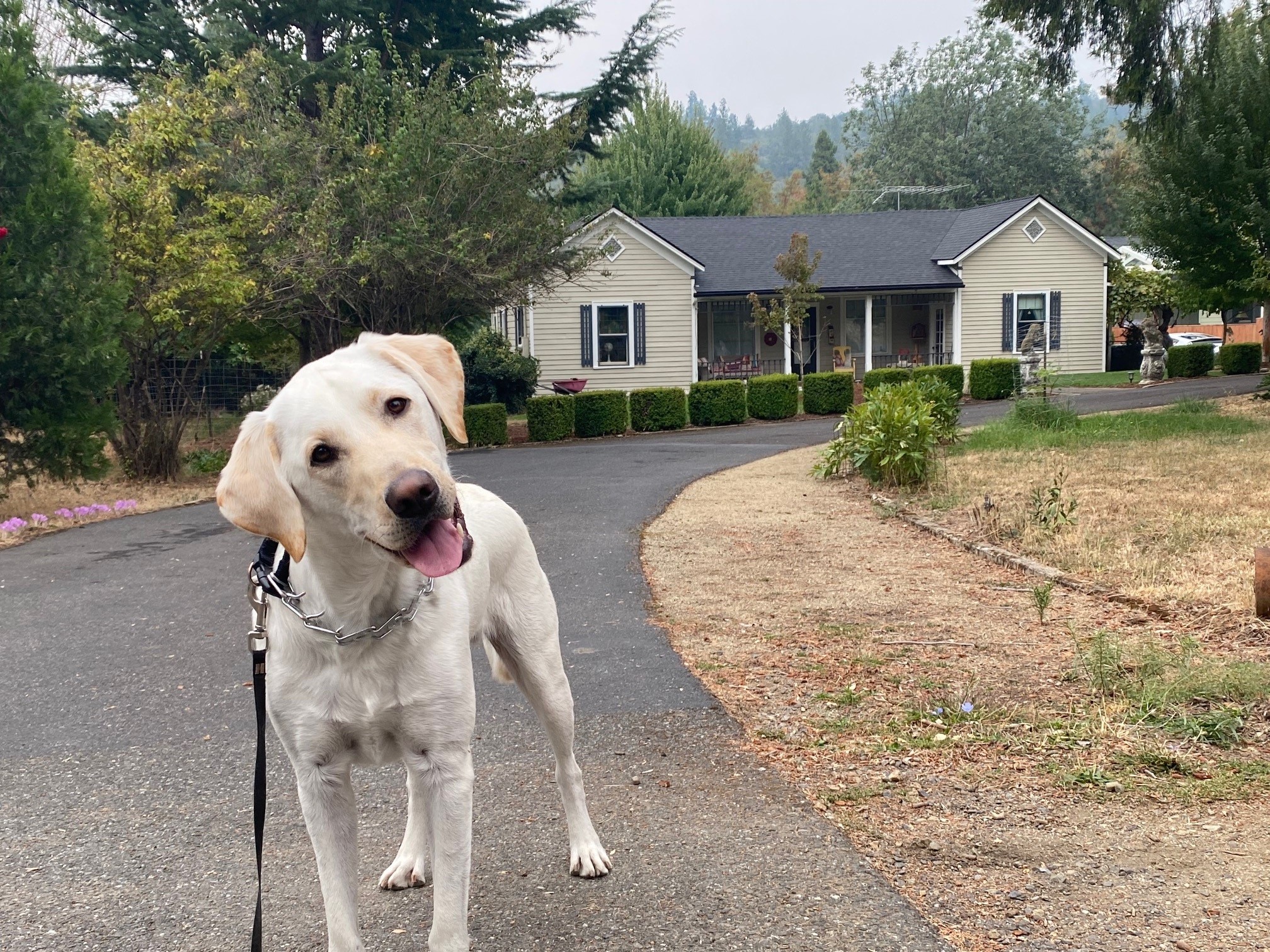 |
Cameron House
Mozzie, our playful yellow Lab tour guide, is checking out what’s known as the Theodoric Cameron House at 425 South Applegate Street.
Perhaps it should more accurately be known as the “Krause House.” When Cameron married the 33-year-old widow Mollie Krause in 1892, she already owned the 1-story wood frame dwelling. Mollie had purchased it in 1890 from her mother-in-law, Margaret Krause, for $1,000 after the death of her husband, Frank, proprietor of “The Oregon Sentinel” newspaper.
We’re not sure how Theodoric Cameron had met Mollie. He had come to Oregon with a brother in 1852 and mined for 2 years before taking up a donation land claim near Eagle Point. In the late 1850s he operated a bakery at Sterlingville then moved to the Applegate where he resumed farming. 1861 found him again engaged in mercantile pursuits, this time at Uniontown—a venture that lasted over 30 years. In 1872, Cameron opened the very productive Sterling Mine, the largest hydraulic mine in Oregon. He later developed other mines in Galice and Waldo.
After marrying Mollie, he managed his various business interests from Jacksonville. Cameron also played an active role in state politics, being elected as State Representative in 1885 and again in 1890, and State Senator in 1896.
Despite Mollie being 30 years his junior, Cameron outlived her by 10 years, passing away in 1914 at the age of 85.
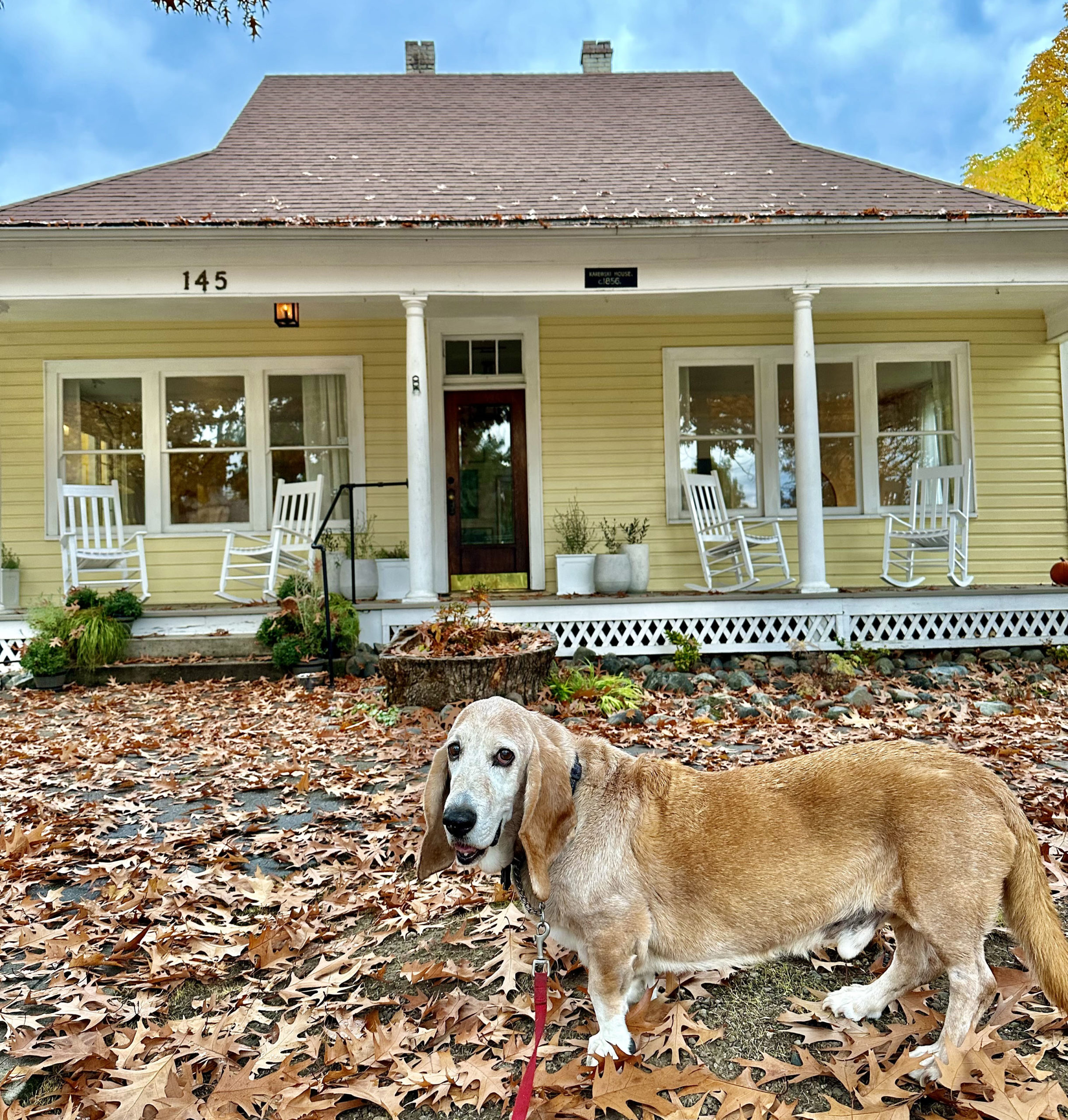 |
Greenman House
Today Trevor is visiting the Gustav Karewski house at the corner of C and North 5th streets—although the house might more appropriately be called the Johanna Levi house, or even the Dr. E.H. Greenman House. In 1866, Greenman purchased the corner lot for his doctor’s office and 1 year later purchased the adjacent lots and built the initial dwelling next to his office. The widowed Johanna Levi purchased this Jacksonville home in 1870 before marrying Gustav Karewski.
Karewski, a native of Prussia, had arrived in Jackson County by 1856. He became a prosperous dry goods merchant and miner. When farming became more important than mining, Karewski opened Karewski’s Agricultural Implements, dealing in plows, graders, harvesting machines, and steam-powered tractors.
The Karewskis made several alterations to the original 1867 structure including additions, porches, and the gabled hipped roof. After Karewski’s death in 1890, other alterations were made. The property remained in the family until the death of Johanna’s daughter, Stella Levi, in 1935.
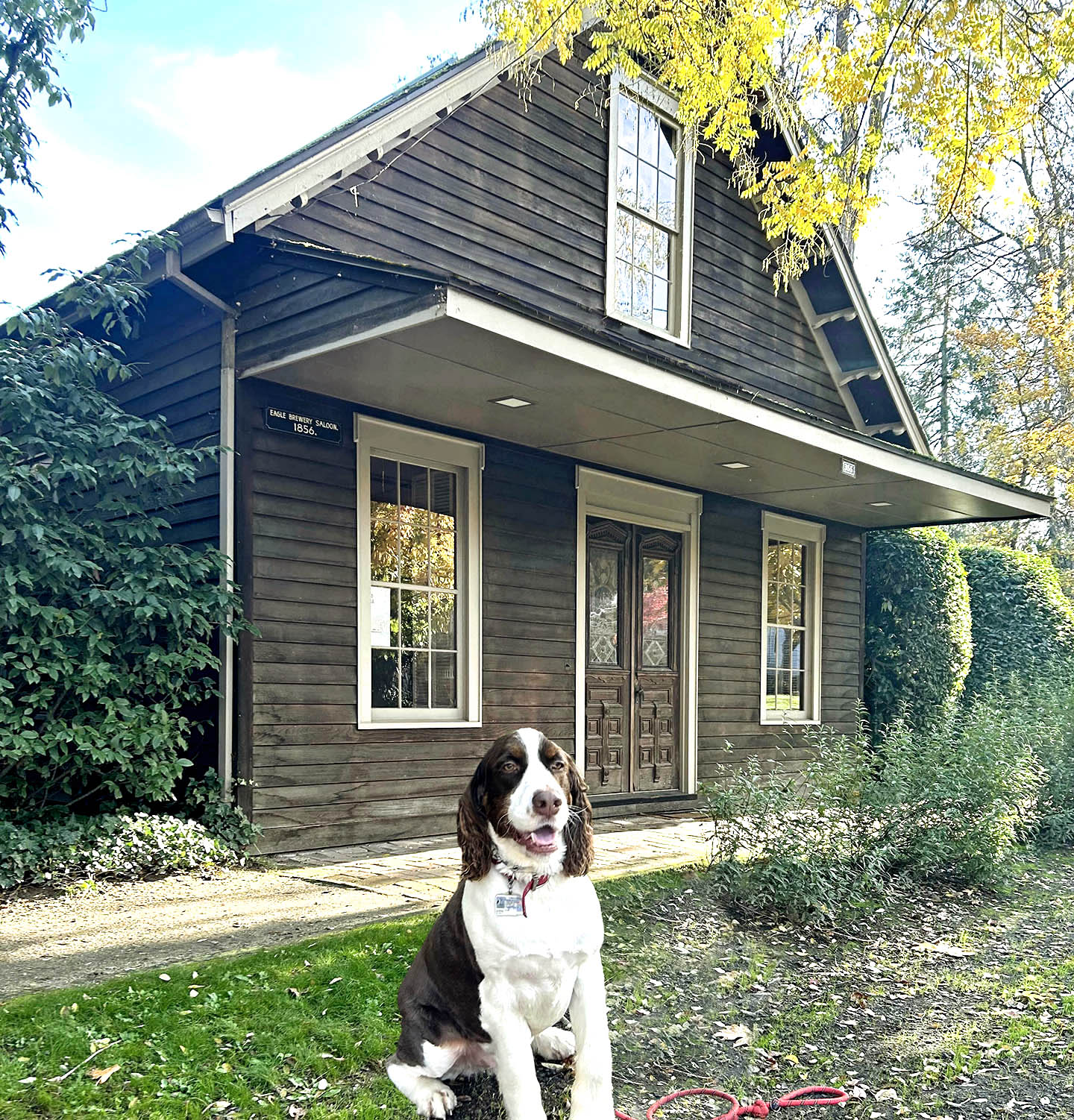 |
Eagle Brewery Saloon
Today Jaxon has sniffed out the Eagle Brewery Saloon building at 355 South Oregon Street. The original brewery, in operation no later than 1856 on the block between California and Main streets, was probably Jacksonville’s first brewery. By 1859 the Brewery was in existence at its current location and under the ownership of German-born Joseph Wetterer.
Two years later Wetterer “commenced the building of a large beer saloon in front of his brewery.” For the next 18 years, Wetterer and his wife Fredericka ran the saloon, advertising “the best lager beer in Southern Oregon.”
Little is known of Wetterer; he seems to have been uninvolved in the town’s social, political or fraternal activities, and does not even appear to have owned a liquor license. Fredericka continued operating the brewery for a period after Wetterer’s death in 1879, but by 1892 the Eagle Brewery and its complex of buildings containing the “malt kiln,” “mash tub,” “cooler,” “furnace heat,” and “beer kettle” were no longer in operation, the saloon stood vacant, and the property was labeled “dilapidated” on local maps.
In the 1960s, the complex became the studio and residence of nationally known artist Eugene Bennett, a far cry from its more raucous years as one of Jacksonville’s earliest saloons. It now serves as a private residence.
 |
Love House
We’re introducing you to Rhoda, a new member of our Walkabout Wednesday Club. The Club honors Storm Large, Jacksonville’s Great Dane “history ambassador,” who, on every Wednesday for over 7 years, shared our town’s historic sites and their stories.
Rhoda is a 13 pound, 4-year-old Norwich Terrier who moved all the way to Jacksonville from Idaho, and she loves it here! That’s why she chose to visit the Love House at 175 North 3rd Street.
John Love was a successful tin and hardware merchant and one of Jacksonville’s first trustees. He served on committees responsible for securing plans to build the town recorder’s office and fire station and inspecting and adopting the 1862 town plat. But Love’s political interests were not limited to Jacksonville. He played an active role in the regional Democratic Party and served as a Jackson County Commissioner from 1860 through 1866. Love was also instrumental in establishing the Jacksonville cemetery, and his mother, Margaret Swan Love, was the first person buried there—even before the cemetery officially opened.
Around 1867, Love built this house for his growing family. Their stay, however, was brief. Within months John succumbed to tuberculosis; a year and a half later, his wife Ann Sophia and one of their daughters died in the smallpox epidemic of 1869. The remaining children were raised by their grandmother, Mary Ann Harris Chambers. You can read more about the Love family and Harris Chambers in Historic Jacksonville’s Pioneer Profiles: historicjacksonville.org/pioneer-profiles.
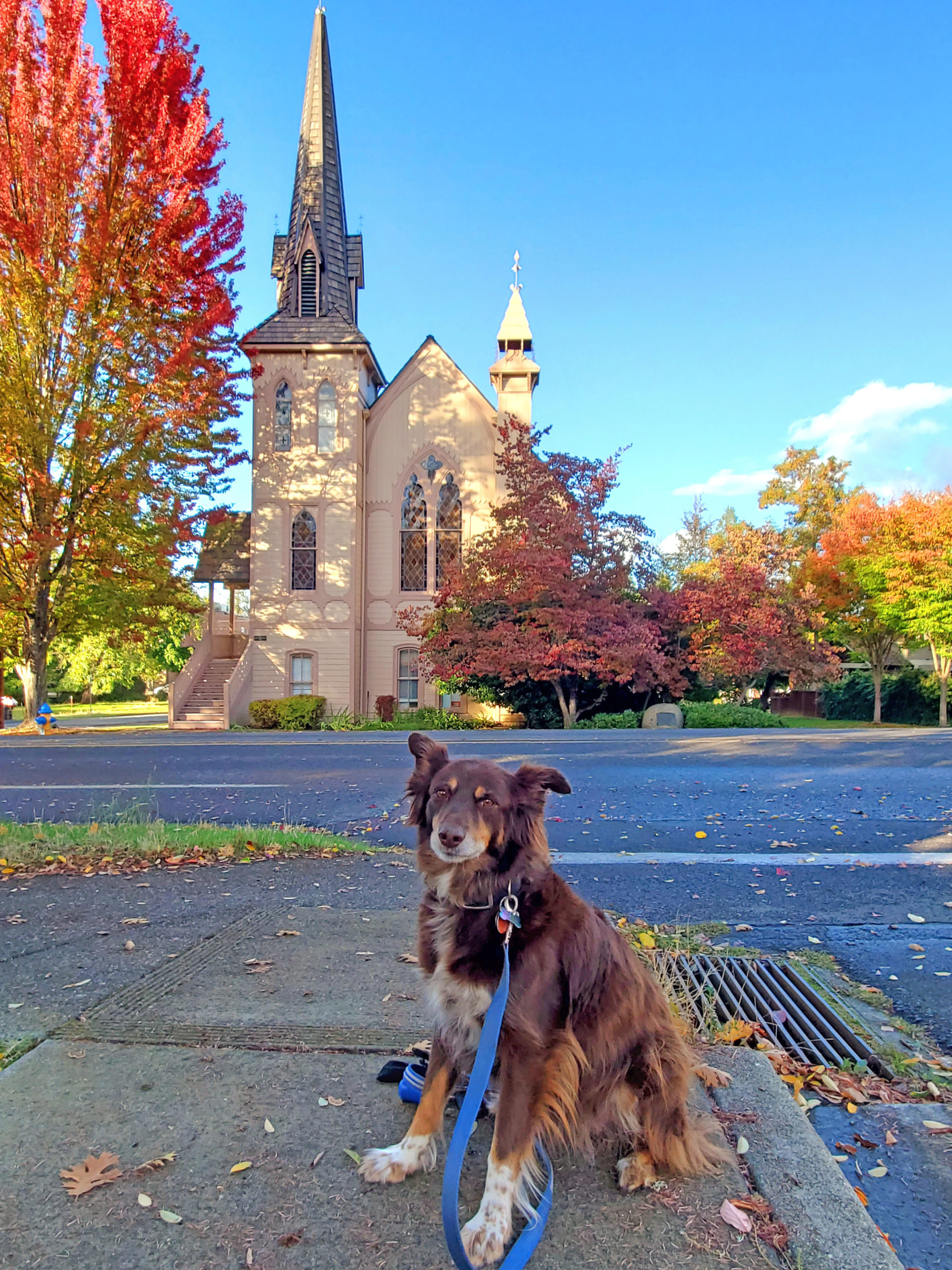 |
Presbyterian Church
Today Gracie is admiring Jacksonville’s glorious fall colors and the historic Presbyterian Church. Located at the corner of 6th and California streets, the church is one of Jacksonville’s most striking examples of Victorian Gothic architecture.
For 24 years prior to its construction, the local Presbyterian congregation had been meeting in various locations throughout the Rogue Valley, including Jacksonville’s Methodist Episcopal Church, schoolhouses and private homes. Plans for their own “religious edifice” got underway in 1878 when William Hoffman and C.C. Beekman purchased the land.
The design of the building may have been inspired by one of the architectural pattern books popular at the time or supplied by the Presbyterian Board of Church Erection. Brick mason, George Holt, laid the foundation; carpenter David Linn constructed the wood frame, roof and belfry. Beekman made a special trip to San Francisco to purchase a 1,000-pound bell for the belfry. While the estimated cost for the structure was $4,500, the actual cost was more than $6,000, half of which was contributed by Beekman.
The church was dedicated on December 4, 1881. After its completion, it was eulogized in journals and newspapers as “a model of architectural beauty” and “the most ornate and handsome [church] in Southern Oregon.”
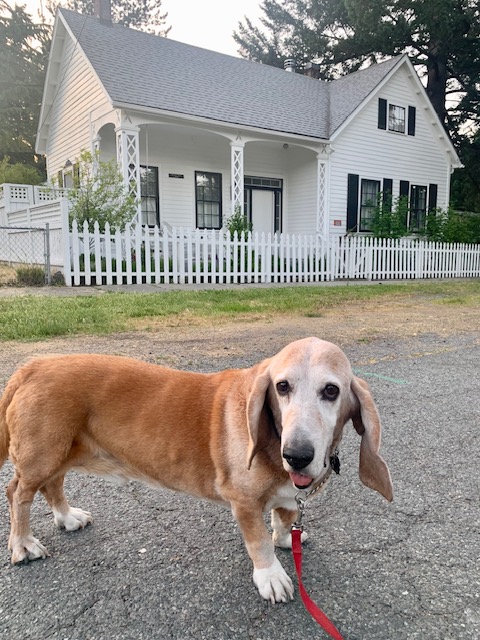 |
Obenchain House
Trevor, our favorite “bagel” (Bassett/Beagle), is visiting what’s known as the Obenchain House at 355 North 4th Street. However, it was actually built by David Hopkins around 1868—the second house he built on this site after the first house burned. Hopkins never married so it’s possible he built the house as a rental investment.
Hopkins was born in 1824 in New Brunswick, Canada. Like many others, he emigrated to California following the discovery of gold then came to Oregon in the fall of 1850. By 1851 he was located in the Rogue Valley where he lived the rest of his life. Hopkins was known for his enterprise and energy in the mining and lumber industries. It’s recorded that he supplied all the timber for the 1867 Jacksonville schoolhouse built on Bigham Knoll. He also pursued farming in the area.
Minnie Obenchain purchased the 4th Street house around 1901. Madison and Minnie Obenchain had been early Jacksonville residents but moved to Klamath County in 1881 where they established a ranch. After the death of her husband Madison, Minnie returned to Jacksonville. She later married George Lewis, the proprietor of the Union Livery Stable.
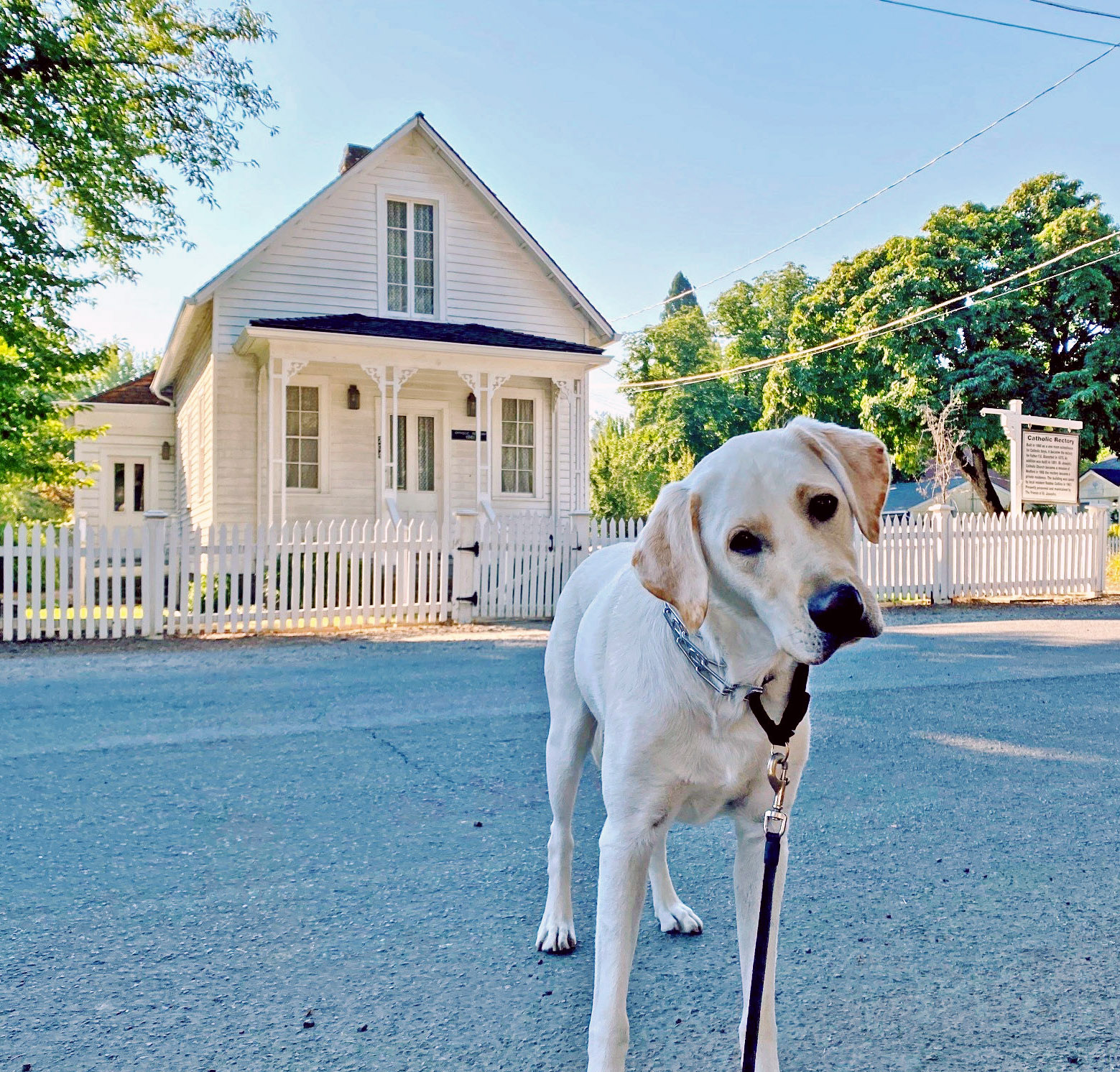 |
St. Joseph’s Catholic Rectory
Our tour guide today is Mozzie, a 1 ½ year old playful yellow Lab who loves excursions through Jacksonville.
Mozzie is at 210 North 4th Street. The building is known as St. Joseph’s Catholic Rectory, but it was not used for that purpose until 1875. Built around 1868, it was probably the home of Nathaniel Langell whose brother had acquired the property in 1859.
For many years Langell ran a boot and shoe store and repair shop at various locations on California Street. He served as President (Mayor) of the Jacksonville Board of Trustees; he was elected in 1872 and again in 1896 as a Jackson County representative to the State Legislature; and for a period he was Master of the local Masonic lodge. Later in life he was appointed U.S. Forester of the Cascade Rogue Forest Reserve, i.e., Forest Supervisor of the Rogue River National Forest.
In 1875, Reverend Francis Xavier Blanchet purchased the property for his residence. For 25 years Blanchet was the parish priest for St. Joseph’s Catholic Church at the other end of the block. In addition to being Blanchet’s residence, the Rectory housed an early Jacksonville library and served as a Catholic boys’ school for a number of years. Blanchet was also the driving force behind St. Mary’s Academy, originally housed in what is now Beekman Square prior to its being relocated to Medford.
Admittedly, Mozzie does appear puzzled about the school part. The Rectory doesn’t look anything like the obedience school he attended….
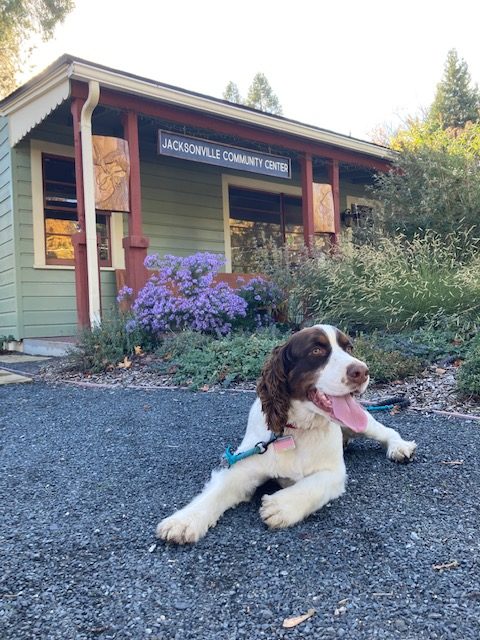 |
Jacksonville Community Center
Although the 1946 core of the remodeled and expanded building at the corner of Main and South 4th streets, also known as the Sampson/Miller property, is not one of our town’s more historic structures, it certainly retains a piece of Jacksonville history.
The property was originally part of “Gunsmith” Miller’s estate. In 1883, John Miller had purchased the entire block, consisting at the time of 2 wood frame buildings and a dense thicket of trees, later referred to as an “orchard.” The building at the other end of the block that formerly housed Jacksonville’s administrative offices is the bottom story of what was Miller’s elegant 3-story Queen Anne-style home built in the 1880s. The Sampson/Miller property was the site of Miller’s stable, shed, and orchard. A 1944 fire destroyed the top 2 floors of the Miller home.
With post-war housing at a premium in 1946, the Sampson/Miller 4th street corner property was sold to Jaftel L. Potter who built the original modest structure at the core of the community center. The property passed through multiple owners over the years, eventually winding up in the hands of Robert and Martha Sampson in 1994. In 1998 they sold it to the City of Jacksonville, and for 20 years prior to its expansion and remodel, it served as the town’s Senior Center which also served as a community gathering place.
Now the Jacksonville Community Center aka Sampson/Miller house will make its own history as it serves as a gathering place for people of all ages for years to come.
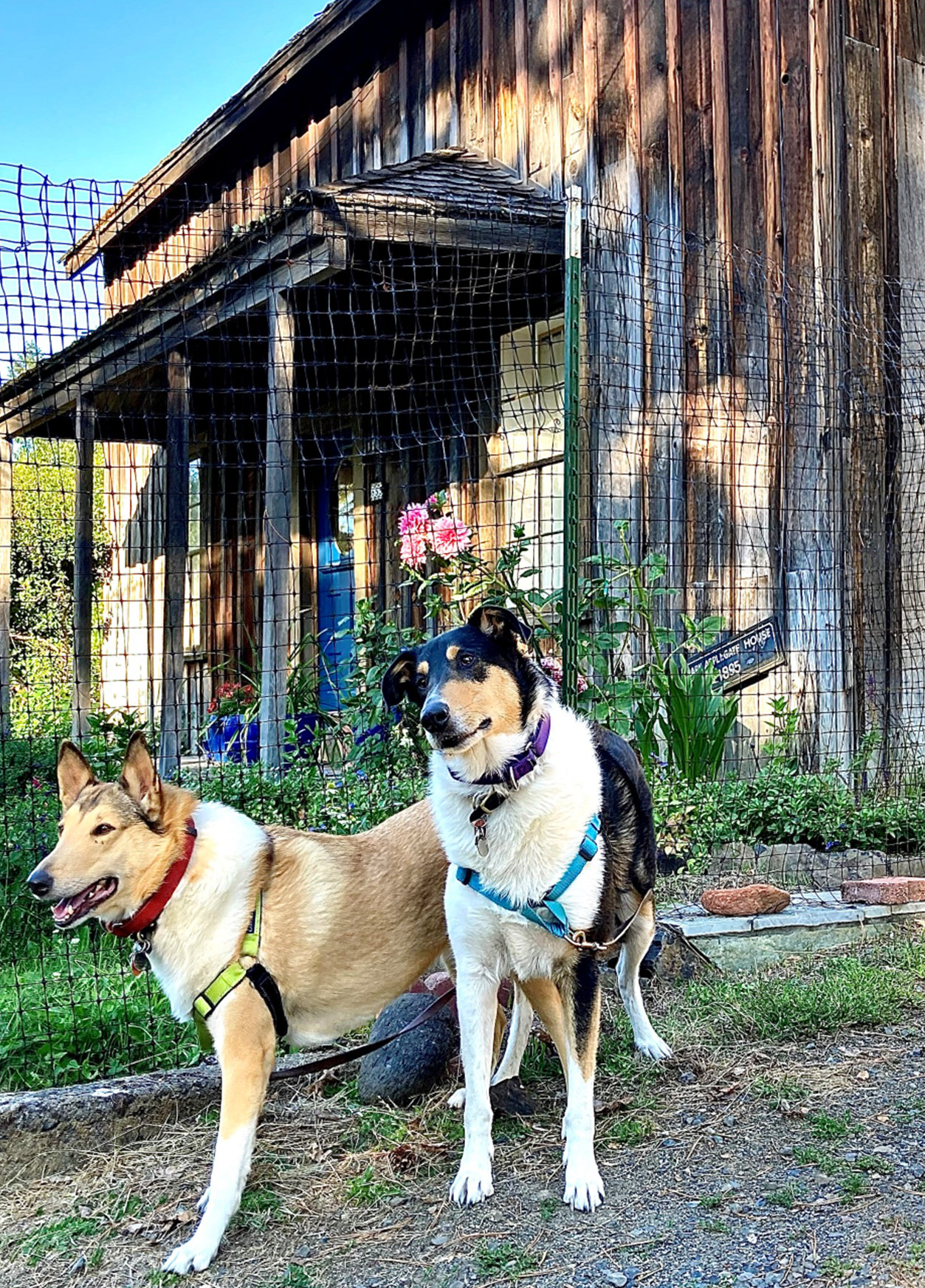 |
Mark Applegate House
Ariel and Caliban, 5-year-old smooth Collies, are visiting one of Jacksonville’s few board and batten houses.
Located at 655 South 3rd Street, it’s commonly known as the “Mark Applegate House,” although it would be more accurate to call it the “Josephine Applegate House.” If the Applegate name sounds familiar, that’s because Josephine was married to Peter Applegate, the youngest son of Jesse Applegate of Applegate Trail fame. Jesse was considered the most influential member of Oregon’s provisional legislature and one of the top 100 leading citizens during Oregon’s first century.
His son Peter was a Jackson County surveyor and was elected 3 terms as County Recorder and 1 term as County Assessor before being appointed as state land agent. In 1872 he had married Josephine Estes who acquired this property in 1903. This 1 ½ story wood unpainted wood frame structure would have been constructed about that time.
Mark Applegate, who is often associate with this house, was one of 10 children born to Peter and Josephine. Peter Applegate died in 1916 and 3 years later Josephine sold the house.
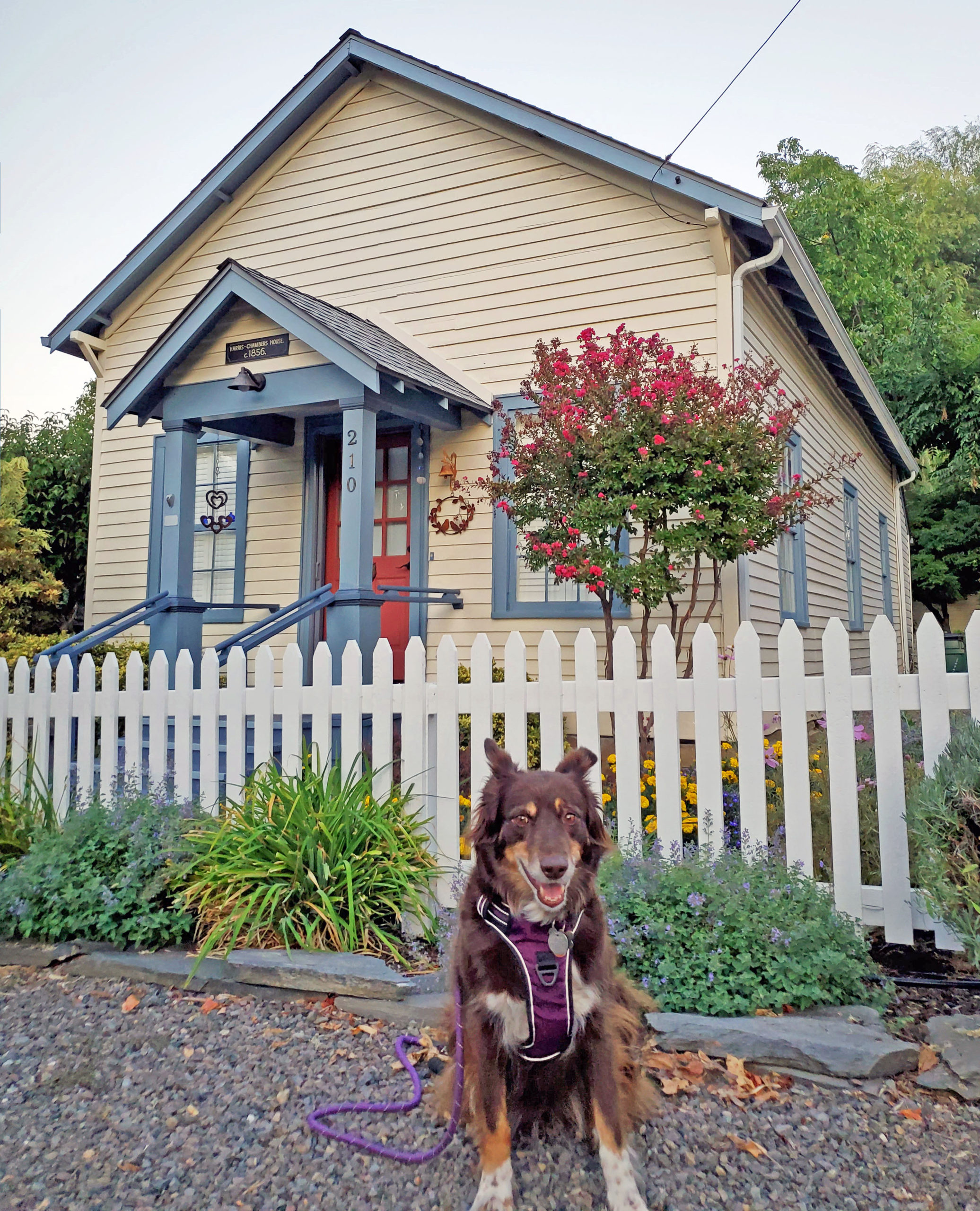 |
Mary Ann Harris-Chambers House
Our tour guide this week is Gracie, an 8-year-old Australian shepherd rescue dog, who relates to the survival instincts of our featured home owner, Mary Ann Harris-Chambers.
The Mary Ann Harris-Chambers house at the corner of North 3rd and C streets in Jacksonville was built around 1867, replacing her earlier home on this site. She moved to Jacksonville with her daughter from a homestead north of Grants Pass after an 1855 Rogue Indian raid killed her first husband, George Harris, and her son. With her daughter reloading, Mary Ann had fired the family’s shotguns from various cabin windows, holding off the attack for over 5 hours until the Indians gave up and left.
Not only did she hold off an Indian attack that cost the lives of her first husband and son, she took in her daughter and 4 young grandchildren after her son-in-law died from tuberculosis in 1867. To accommodate 3 generations, she razed her old home and constructed what we know as the Harris Chambers house on Jacksonville’s North 3rd Street.
When her daughter and a granddaughter died in a smallpox epidemic in 1869, she raised her 3 surviving grandchildren. Following the death of her second husband, Aaron Chambers, 6 months later, she moved with all the grandchildren to his farm, located 1 ½ miles outside of Jacksonville next to the J. Herbert Stone Forest Service tree farm on what we now call Hanley Road.
Mary Ann Harris Chambers picked up the pieces and went on with her life. After all, that’s what she had learned to do—she was a survivor.
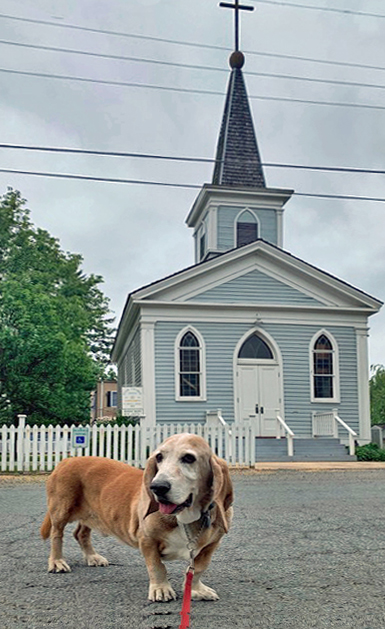 |
St. Joseph’s Catholic Church
Trevor is visiting St. Joseph’s Catholic Church at 280 North 4th Street, the oldest Catholic Church still standing in Southern Oregon. Shortly after the discovery of gold in Jacksonville in the winter of 1851-1852, Reverend James Croke celebrated the first Catholic mass in the home of a local resident. In 1855, Croke reported to the Archbishop that he had counted 105 Catholics in the Rogue Valley alone. In 1858, James Cluggage, donation land claim owner of most of the original Jacksonville townsite, deeded the 100’ x 200’ parcel at the corner of 4th and D streets for $5 for “the use and benefit of the Catholic Church.”
St. Joseph’s Catholic Church, dedicated November 1, 1858, was the first parish church built in Southern Oregon to serve the Catholic population. Father Francis Xavier Blanchet was appointed parish priest in 1863 and served in that position for 25 years. In its early years, St. Joseph’s had many missions attached, some as distant as Corvallis to the north and Lakeview to the east. Today St. Joseph’s is a mission of Sacred Heart Catholic Church in Medford.
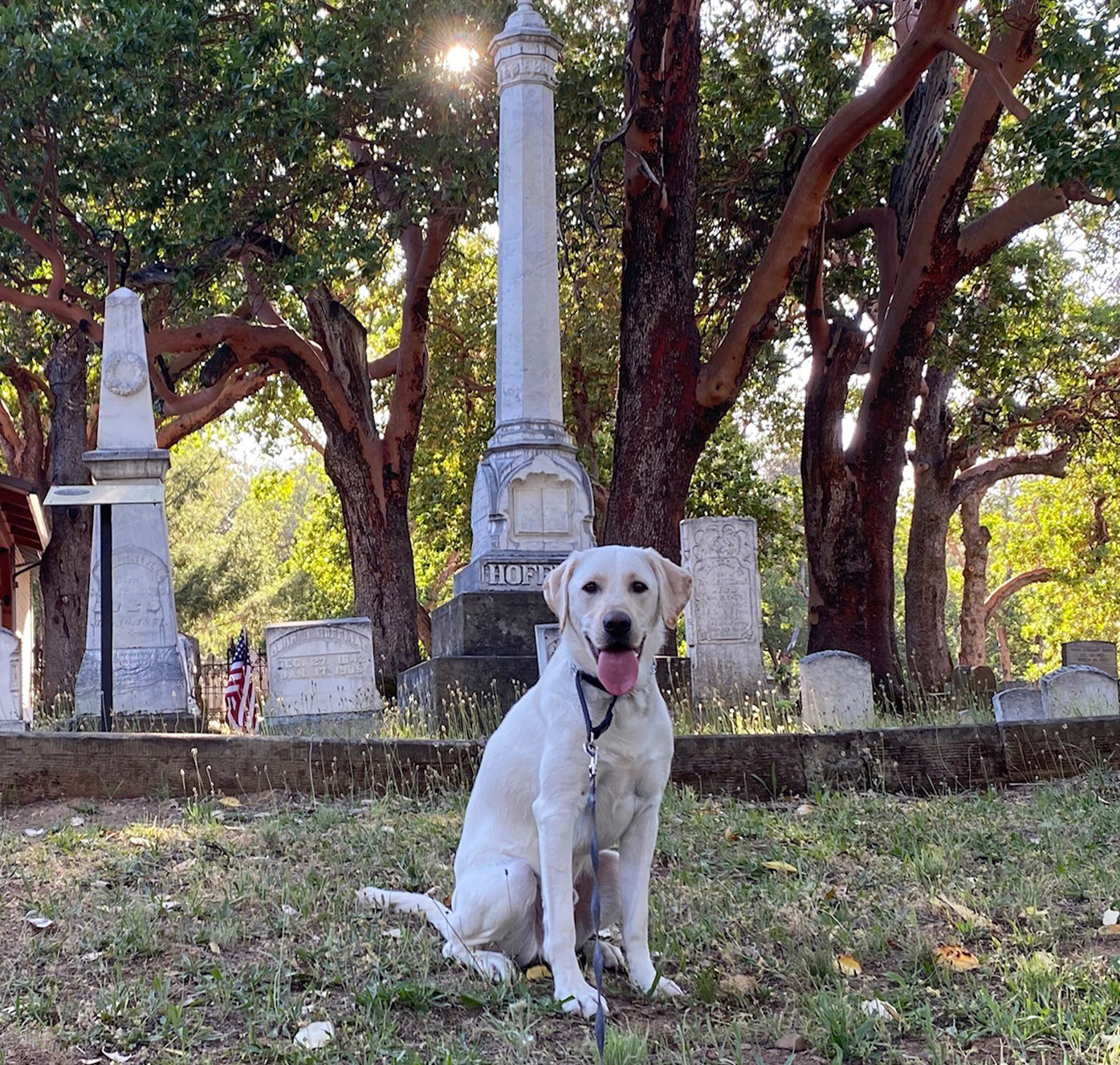 |
Hoffman Cemetery Plot
Mozzie is visiting one of his favorite places – Jacksonville’s pioneer cemetery. Today he is at the grave block of the Hoffman family in the cemetery’s city section. William Hoffman served Jackson County as its first auditor under territorial laws and as its first County Clerk when Oregon achieved statehood.
William and his wife Caroline had come across the Oregon Trail from Indiana in 1853. They brought with them something considered more valuable than gold in a predominantly bachelor settlement—6 marriageable daughters!
The family traveled the Trail as part of a “preacher wagon train,” avoiding traveling on Sundays. Devout Presbyterians, William helped create the Presbyterian community in Jacksonville. Reverend Moses Williams established the first Presbyterian congregation in the Hoffman home, and he and his wife Amelia are also buried in the Hoffman block.
The Hoffman daughters did indeed marry well. Daughter Florence, whose first marriage was to a county judge, Thomas Shipley, lies here along with their grown daughter Maggie and her baby. The marble “French cradle” was created by Florence’s second husband, stone mason J.C. Whipp, for their young daughter Carrie.
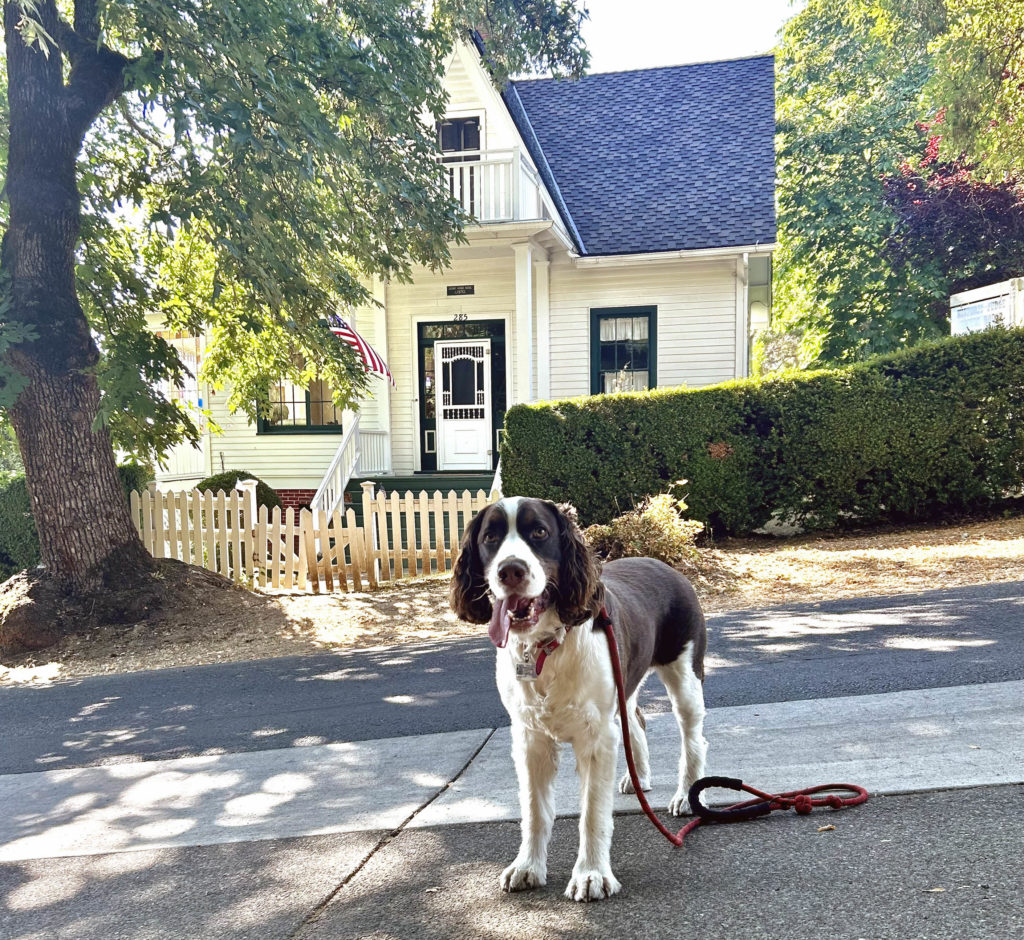 |
Judge Hanna House
Jaxon is at what’s now known as the Judge Hanna House at the corner of 1st and Pine streets in Jacksonville. However, the house was actually built in 1868 for another Judge, Legrand J.C. Duncan. Duncan, born in 1818, was older than most of the fortune seeking miners when he arrived in Jacksonville. After serving as Sheriff of Jackson County, Duncan was elected Jackson County Judge in 1860, a position he held for the next 10 years. Following his retirement, he took up the gentlemanly pursuit of gardening, perhaps inspired by his neighbor across the street, Peter Britt. Duncan died of typhoid pneumonia at age 68.
It was not until sometime after 1885 that Judge Hiero K. Hanna purchased and resided in the house. A native of New York, Hanna headed west in 1850 when he was 18. He realized some mining success in California before moving on to Josephine County where he was elected District Attorney. Only after opening a law practice in Jacksonville in 1874 did Hanna actually study law. He was subsequently elected District Attorney for the area covering Jackson, Josephine, Lake and Klamath counties. In 1884 he was appointed circuit court judge and in the 1880s also served as a trustee of the City of Jacksonville.
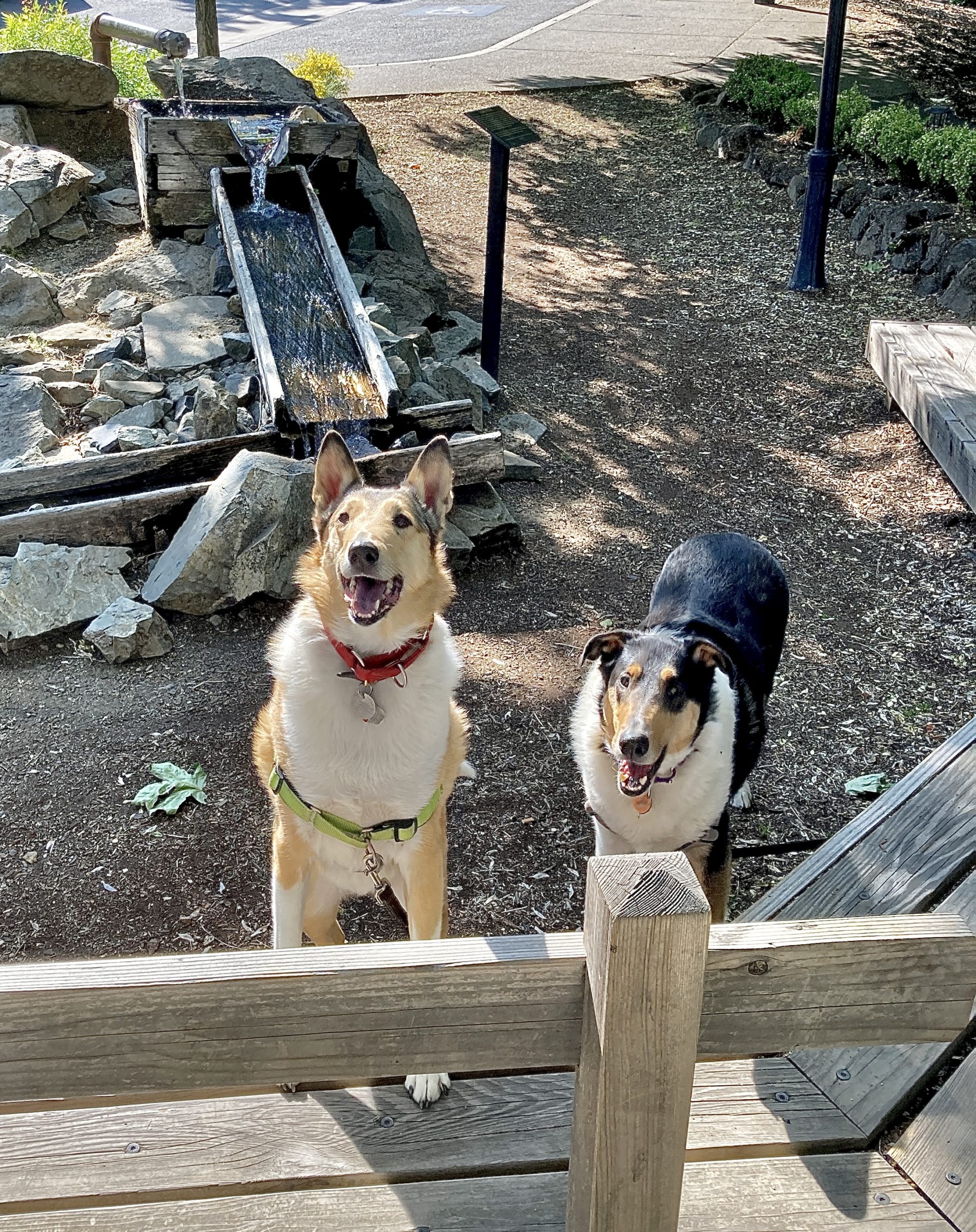 |
Long Tom Sluice Box
Ariel and Caliban are at the “long tom” sluice box on West Main Street. This stretch was Jacksonville’s original business district and later Oregon’s first Chinatown. The “long tom,” installed around 2000, recognizes the gold miners who were the locale’s first residents.
The earliest miners were “placer” miners, scooping creek bottom silt into pans or shoveling it into rockers or long tom sluice boxes and using water to separate valuable ore from sediment. In pans or rockers, the heavier gold settled to the bottom and the miners could pick out the loose flakes and occasional nugget. The sluice box, essentially a sloping trough, allowed more dirt to be searched. Some sluice boxes could be hundreds of feet long, but the long tom is a small one, usually 6 to 12 feet long and 12 to 20 inches wide. It required much less water but a lot more labor.
Dirt would be placed in the upper section, the “tom,” which acted like a large hopper with a screen. As water was poured into the top, a miner would rake it to break up clods and screen out larger rocks. The slurry would then pour into the second section where a series of “riffles,” essentially raised slats of wood, would trap the heavier gold deposits. This is a very simplistic explanation and a lot more information can be found on the internet.
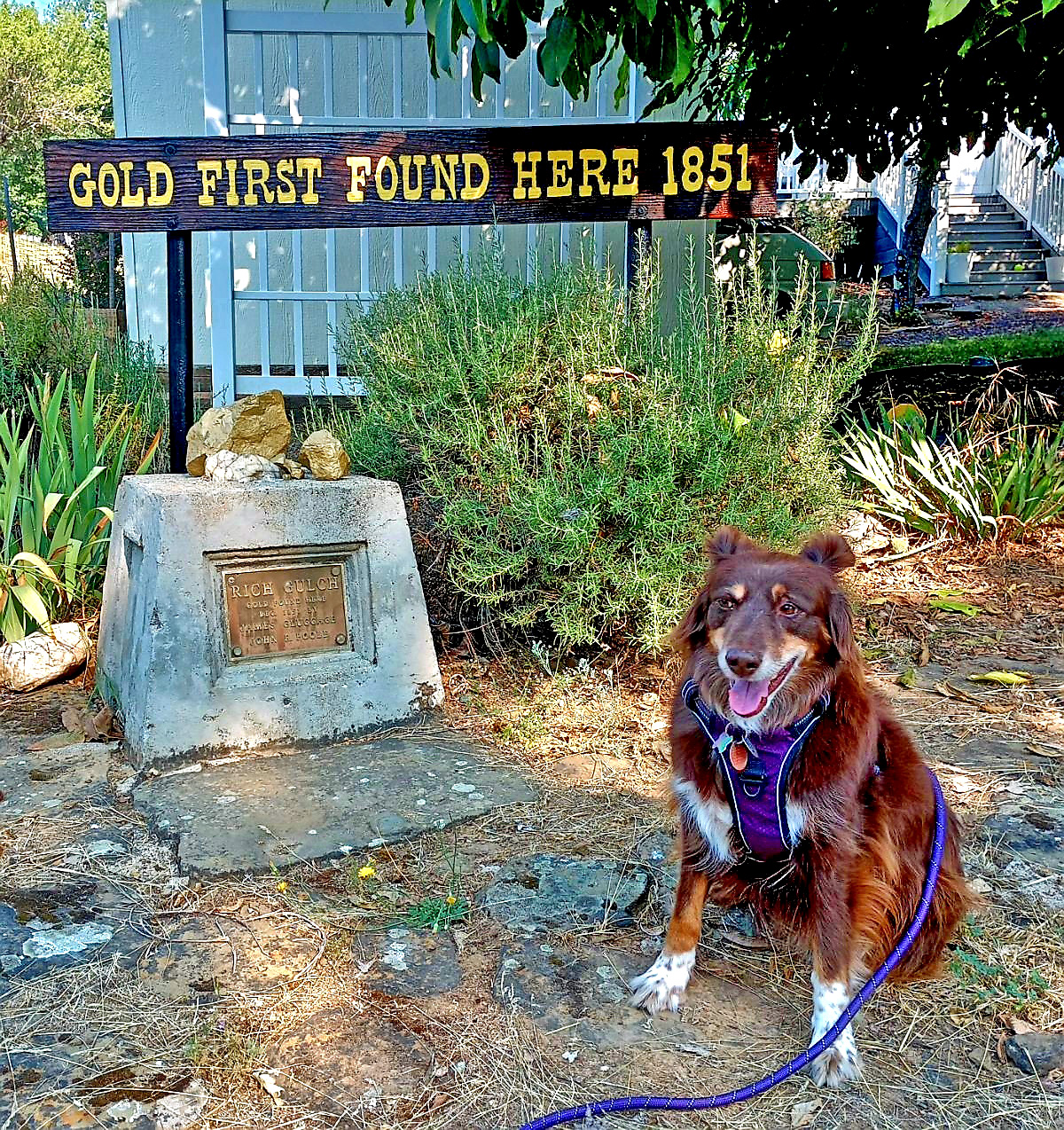 |
Gold First Found Here
Gracie, our 8-year-old Australian Shepherd and rescue dog, is Historic Jacksonville, Inc.’s Walkabout Wednesday tour guide this week.
Have you visited Jacksonville’s “Gold First Found Here” site where Applegate Street crosses Daisy Creek? This is the approximate location where James Clugage and James Pool, two packers carrying goods to the mining camps in California, did a little panning in the creek and found their first “color.”
But the story is a little more complex than the marker would lead you to believe. They were not the first Whites in the area to find gold. That honor probably belonged to the son of Alonzo Skinner, the local Indian agent, and one of his employees, a Mr. Sykes. They had found gold in nearby Jackson Creek the previous fall. Cluggage and Pool learned of the discovery when they spent a night at the Skinner homestead so took time to pan a little before heading to Yreka. And, voila!
Clugage and Pool hightailed it south and immediately filed land claims on what is now most of Jacksonville. They returned and spent the next few weeks mining, but then Clugage did something unheard of—he publicized his “find,” even boasting to California newspapers of taking out 70 ounces of gold a day from his claim. Thousands of miners poured over the Siskiyous into the Valley, closely followed by merchants, gamblers, courtesans, and settlers—all needing a mining, business, or home site.
Clugage did indeed find gold—he made a fortune selling land!
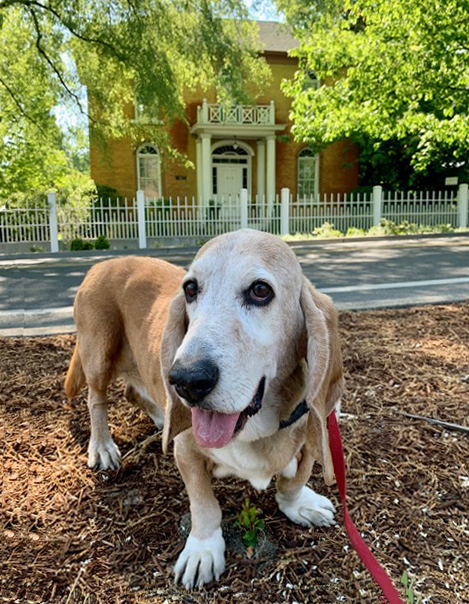 |
Dowell House
Trevor, our 13-year-old “Bagel” (Bassett-Beagle mix), is Historic Jacksonville, Inc.’s Walkabout Wednesday tour guide this week.
Today Trevor is admiring the B.F. Dowell House at 475 N. 5th Street. This Victorian Italianate style home was built for Benjamin Franklin Dowell, named for his grandmother’s uncle, Benjamin Franklin. Dowell served as prosecuting attorney for Oregon’s 1st Judicial District and as U.S. District Attorney. For 14 years he owned the “Oregon Sentinel” newspaper, the first newspaper in the Pacific Northwest to support the abolition of slavery and the first to nominate Ulysses S. Grant for president.
This is one of the earliest Italianate style homes built in Oregon. Constructed in 1861, it may also have been the first home in Jacksonville to be built of brick. Most homes of the period had wood burning stoves for heat, but this distinctive home has 4 fireplaces—one of black onyx and 3 of marble. The marble probably came from Dowell’s own marble quarry on Williams Creek. That same marble was also used for the porch steps and all the windowsills.
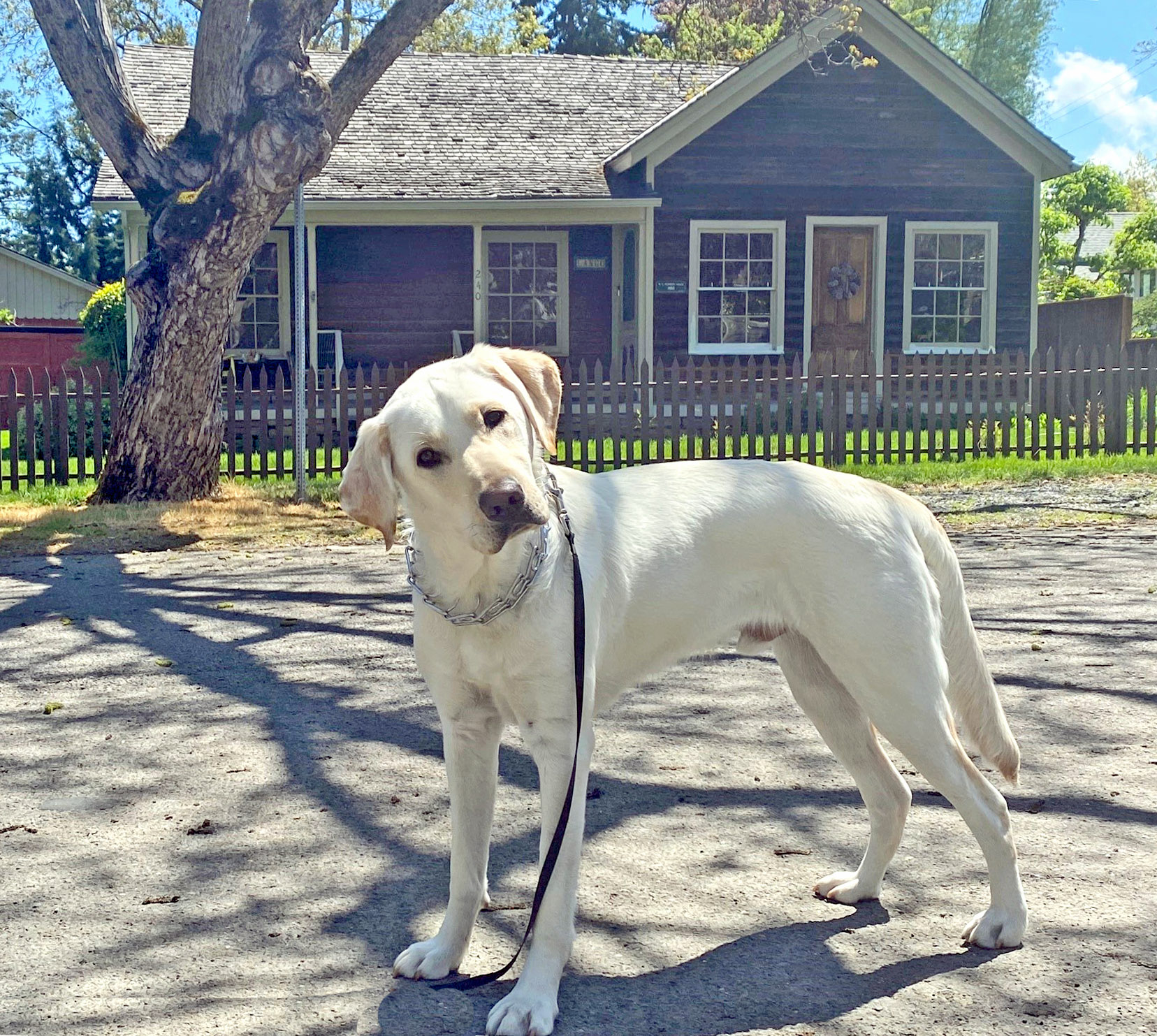 |
Kennedy House
Mozzie, the Club’s 1 ½ year old yellow Lab, is Historic Jacksonville, Inc.’s Walkabout Wednesday tour guide this week.
Today Mozzie is visiting the Matthew G. Kennedy house on North 3rd Street. Constructed around 1855, it’s the oldest Jacksonville residence still standing.
One of the Valley’s earliest pioneers, Kennedy had been appointed town constable in early 1853 at the ripe old age of 23 and became the first elected Sheriff of Jackson County later that year. At the time Jackson County encompassed current day Jackson, Josephine, Curry and Coos counties.
Kennedy also invested in Jacksonville real estate. He was the first Jacksonville settler to record his claim to a 100-foot frontage on the north side of California Street. Around 1854, he constructed 1 or 2 wood frame buildings that housed an “assemblage of shops” known as “Kennedy’s Row.” That site now houses The Pot Rack, Pickety Place, and the historic Beekman Bank Museum.
But Kennedy also had a bit of the wanderlust. In 1857 he left Jacksonville to build a hotel called the Metropolitan House Hotel in Yreka, and by 1863, he had moved on to San Francisco.
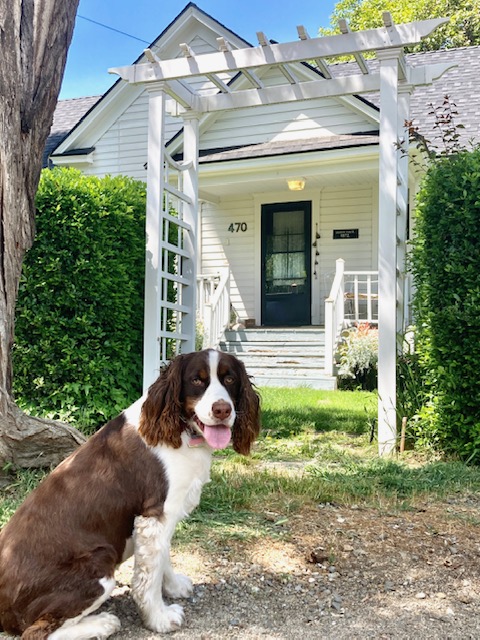 |
Ulrich-McKenzie House
Today Jaxon is visiting the Barbara Ulrich House at 470 South 3rd Street. Constructed around 1888, it’s unique for its eclectic design features including rubblestone foundation and Classical revival, Victorian Gothic, and Queen Anne architectural elements.
Born in Germany in 1822, Barbara and her husband Christian had emigrated to the United States by the 1850s and came west with their family in the 1860s. Their son, also named Christian, was a carpenter and owned a planing mill and sash and door factory at the southeast corner of California and 5th streets. Construction of the original portion of the building is attributed to him.
In 1890, Barbara Ulrich deeded the property to Rebecca McKenzie for $700. Rebecca was the widow of Thomas McKenzie, who, with E.D. Foudray, had established Jacksonville’s first, and very profitable, steam flouring mill on South 3rd. McKenzie had also been a prominent merchant and active in town affairs. He apparently left Rebecca quite well off since in the 1900 Jackson County census, Rebecca was listed as a “capitalist.” This house was probably an investment and used as a rental property.
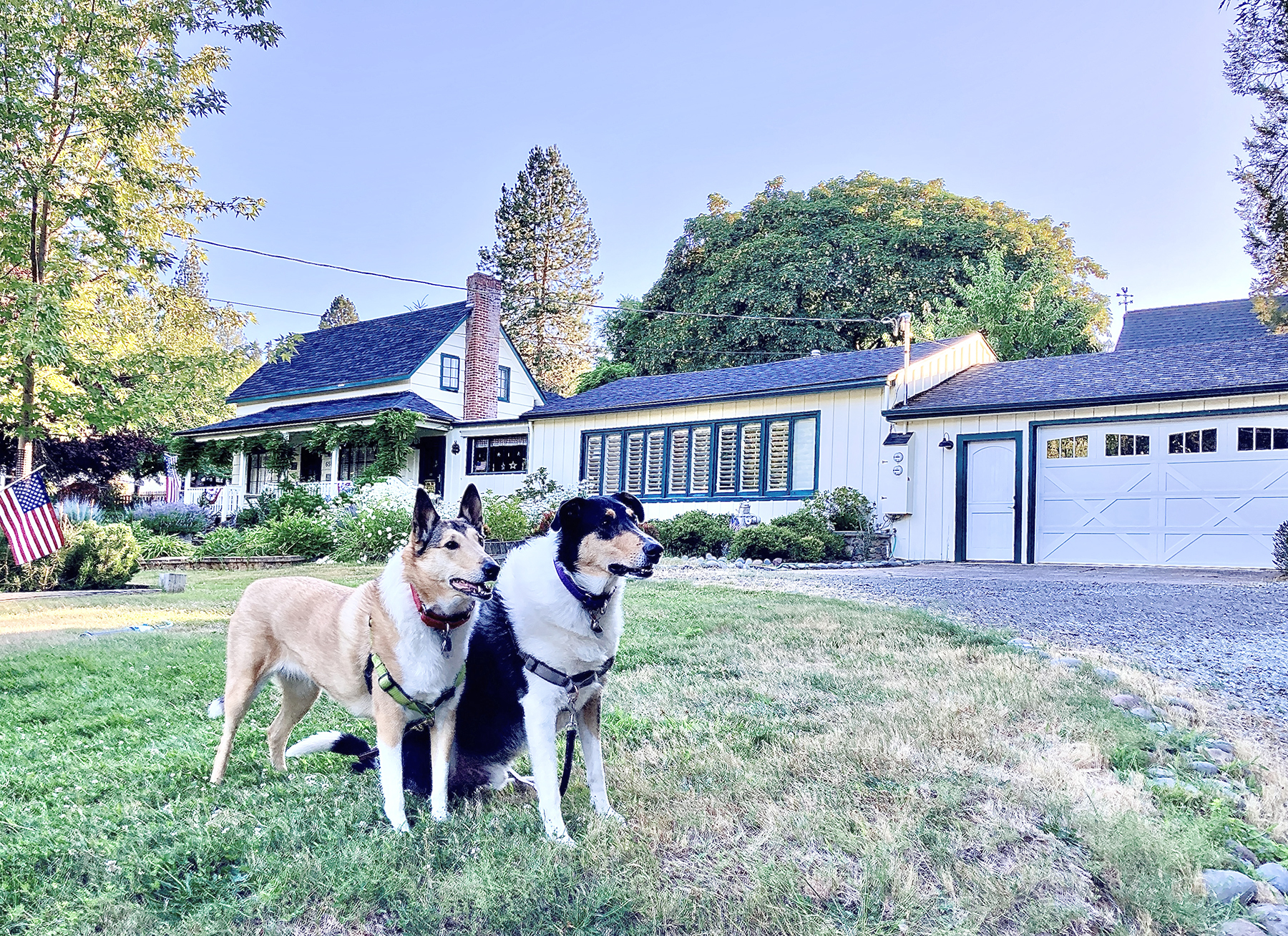 |
Weiss House
Ariel and Caliban are checking out the Weiss House at 650 Sterling Street. The house is actually multiple buildings with “back stories” tracing Jacksonville’s growth.
In 1866, the City deeded a large parcel of land between S. Oregon and South 3rd streets to John Weiss, an immigrant from Alsace-Lorraine. He and his wife Elizabeth had arrived in Jacksonville in 1852 and constructed the original farmhouse no later than 1873. The property was divided following Weiss’ death in 1895 and passed through multiple hands. The portion containing the original farmhouse was usually referred to as “the house near the end of South Oregon Street” since Sterling Street was not yet in existence.
In 1943, the property was bought by A.L. and Olive Kitchen. They made the farmhouse their home while again dividing the property into what became known as “the Kitchen Subdivision,” creating Sterling Street in the process.
The “Kitchen House” was sold to Alvin and Florence Minshall in 1948. Minshall was a building contractor and post-World War II avid recycler. In 1951, Minshall and his friends loaded two barracks buildings and a maintenance shed from Camp White, now White City, onto a flatbed truck and brought them home. They are now the long great room and garage of the current residence.
Camp White was a World War II Army training base. At its peak, the camp occupied nearly 50,000 acres and contained nearly 40,000 people, making it the second-largest city in Oregon at the time.
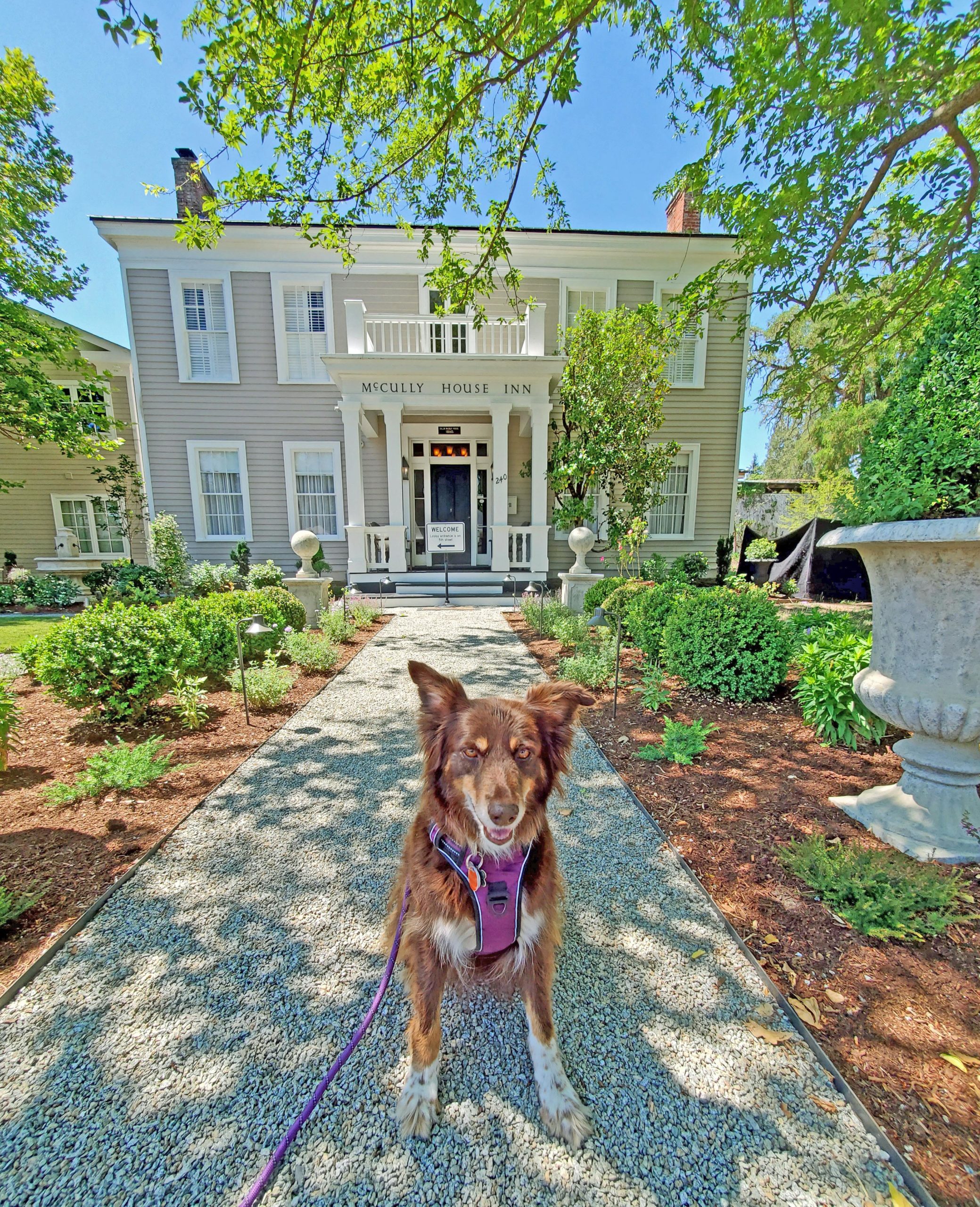 |
McCully House Inn
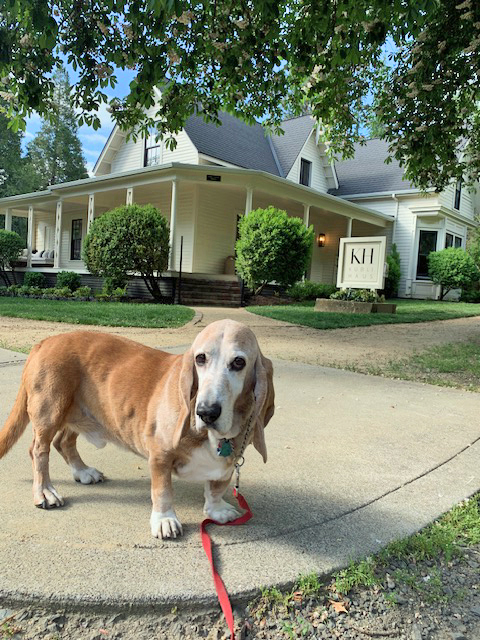 |
Kubli House
Today Trevor is visiting the 1 ½ story wood frame structure at 305 S. Oregon Street in Jacksonville. Although the house was built in 1862 and Kaspar Kubli did not acquire it until 1872, it’s known as the Kubli House (or Kubli Haus) since it was occupied by the Kubli family for 25 years.
Twenty-year-old Kaspar Kubli had immigrated to the U.S. from Switzerland in 1852, arriving in Jacksonville a year later. After mining for 2 winters, he found greater success packing supplies from Crescent City in partnership with fellow Swiss immigrants, Peter Britt and Viet Shutz. With his capital he acquired extensive land holdings in the Applegate where he engaged in farming and ranching.
Moving back into Jacksonville in 1872, Kubli purchased this house along with a tinsmith and hardware business. The latter’s success led to his erecting the 2-story brick commercial building on California Street which still bears the Kubli name.
Kubli was also an active public and civic servant, twice elected Jackson County Treasurer, elected Grand Patriarch of the International Order of Odd Fellows grand lodge of Oregon, and involved in the Presbyterian Church management.
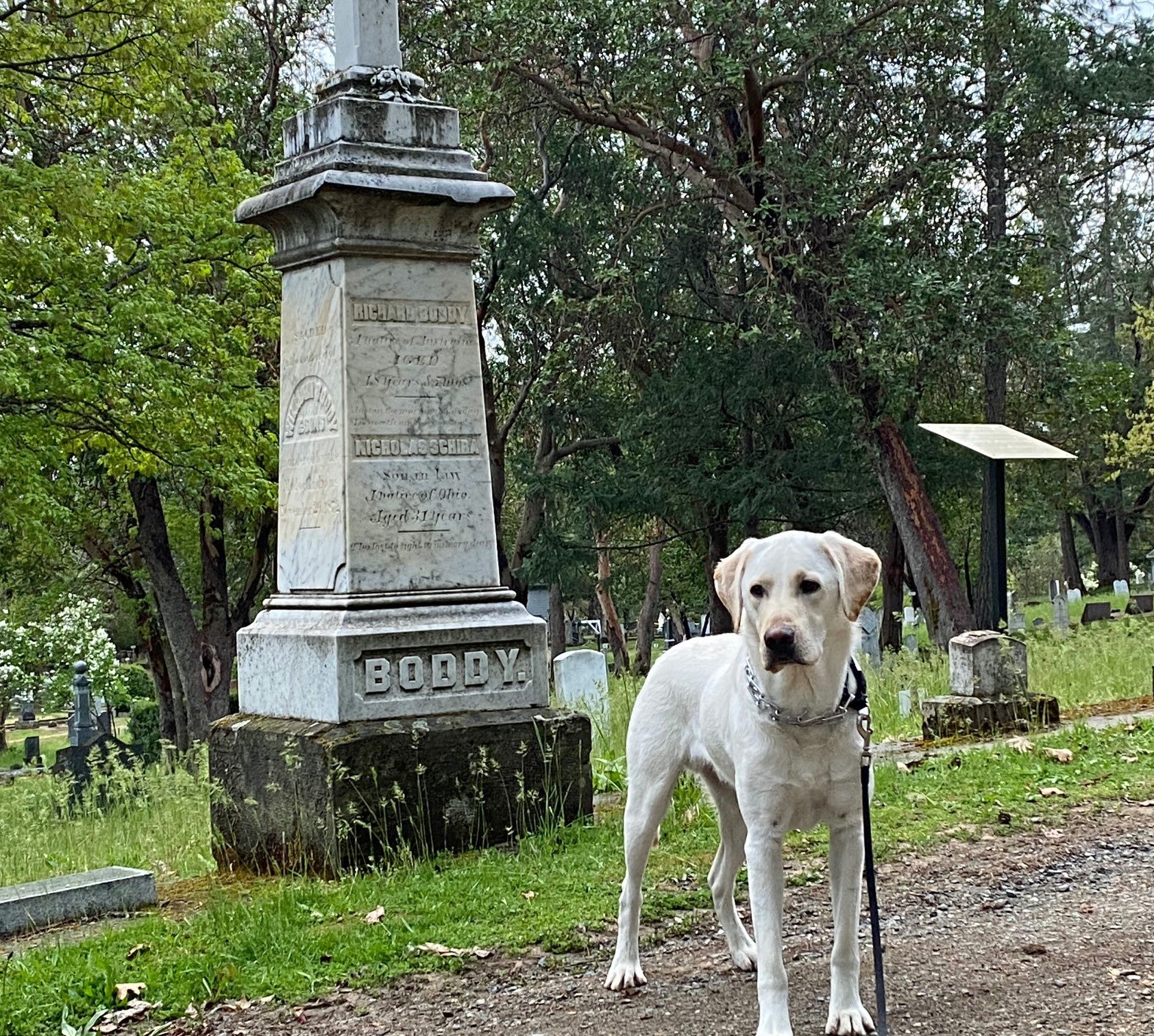 |
Boddy Cemetery Plot
One of Mozzie’s favorite places for daily walks is Jacksonville’s Pioneer Cemetery. Today Mozzie is in the City Section, visiting the grave of the Boddy family, casualties of the Modoc Indian War. William and Louisa Boddy, 2 sons, a daughter, and a son-in-law immigrated from Australia to the Klamath Valley in 1872 to establish a cattle ranch. Only a few months after their arrival, the Bureau of Indian Affairs ordered the Modoc people to be moved into settlements with the Klamath and Yahooskin tribes, their historic enemies, sparking a war between Native Americans and settlers.
A driverless, bloodied wagon was the first sign of trouble for the Boddy family. When Louisa and her daughter Katherine were approached by Native Americans asking if there were men in the house, Katherine took her daughter and ran. They returned a week later only to learn that all their menfolk had been killed. The 2 women were reportedly the only survivors of the Modoc Indian Uprising, and Louisa Boddy was the only woman to receive damages from the U.S. government for her losses. A claim for $6,180 was processed through an Act of Congress and paid by the Bureau of Indian Affairs.
Louisa and Katherine relocated to Jacksonville, and in 1881, Louisa had her family exhumed and reburied in the Jacksonville Cemetery. She had this elaborate marker made by Ed McGrath, a San Francisco marble carver. Both Louisa and Katherine remarried and moved away, but when Louisa died in 1904, Katherine brought her mother to Jacksonville to be buried with the rest of the family.
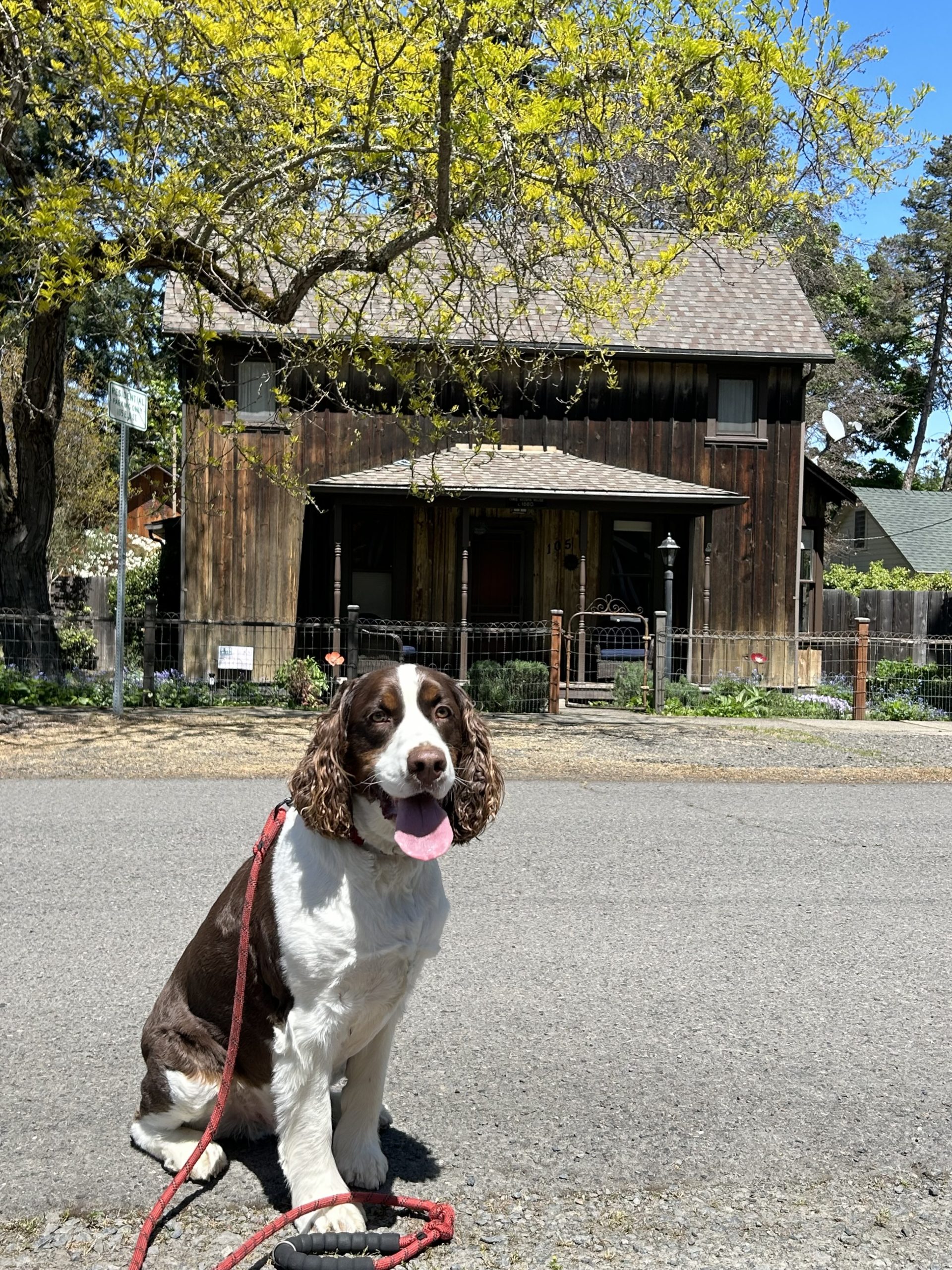 |
Chris Keegan House
Jaxon is visiting the Chris Keegan House at the corner of D and North 3rd streets. It’s one of only four residences in Jacksonville constructed with board and batten exterior sheathing. Although it’s known as the Chris Keegan House, it was actually built for Minnie Obenchain around 1907. The Obenchains had ranched in Klamath County for some 20 years, but Minnie moved back to Jacksonville after her husband Madison passed away. Minnie probably built this house as a rental and Chris Keegan and his family apparently occupied the home for several years before purchasing it in 1919. For many years, Keegan and Harry Luy were partners in the Luy and Keegan Saloon located on the north side of California Street near 3rd.
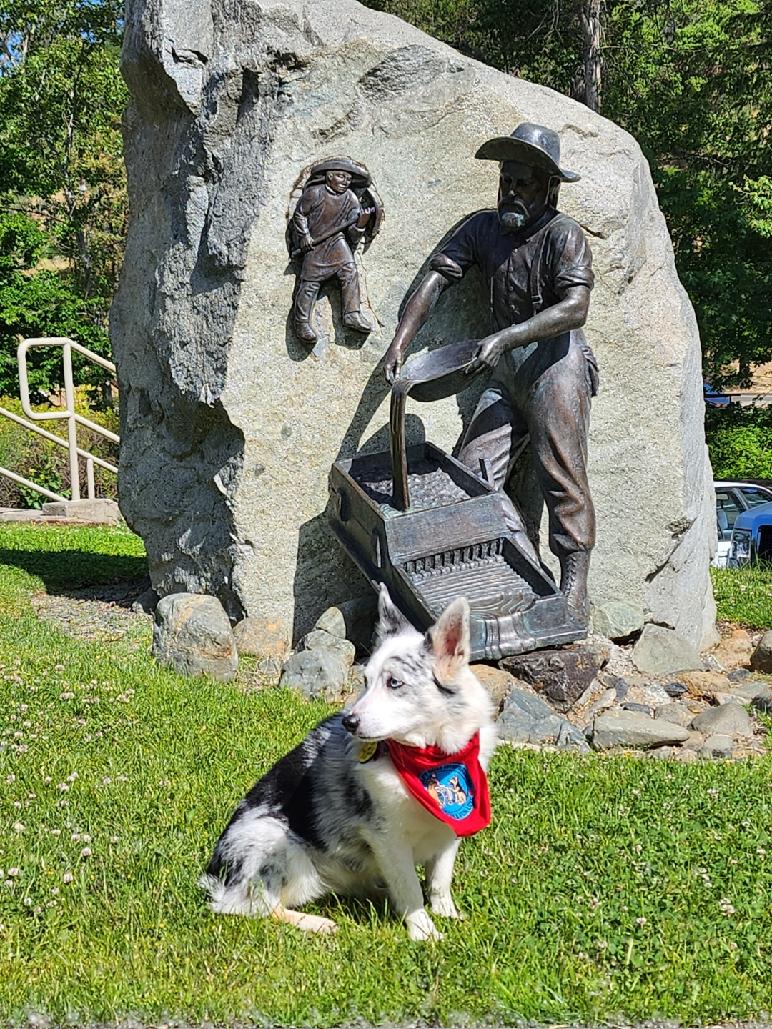 |
Jacksonville Gold Miner Sculpture
Today Tova is in front of the Jacksonville Gold Miner sculpture on the library’s front lawn, created in 2007 by famed British sculptor Alan Collins.
The sculpture commemorates the town’s 1850s gold rush, but did you know that Jacksonville actually had 2 gold rushes? During the 1930s Great Depression, Jackson County gave out mining permits rather than putting able-bodied individuals on the dole, i.e., welfare. These resourceful individuals undermined almost every square inch of Jacksonville looking for any leftover gold.
When the current Jacksonville Library building was constructed in 2003, the contractors discovered a major tunnel, most likely a 1930s enterprise, that began near the bridge west of Jacksonville on what is now Highway 238, passed under the old train depot (now the Visitors Center), ran across North Oregon on the south side of C Street, and followed the “rim” of C Street almost to 4th, ending under the 1930s community center (now the Jacksonville Inn parking lot)!
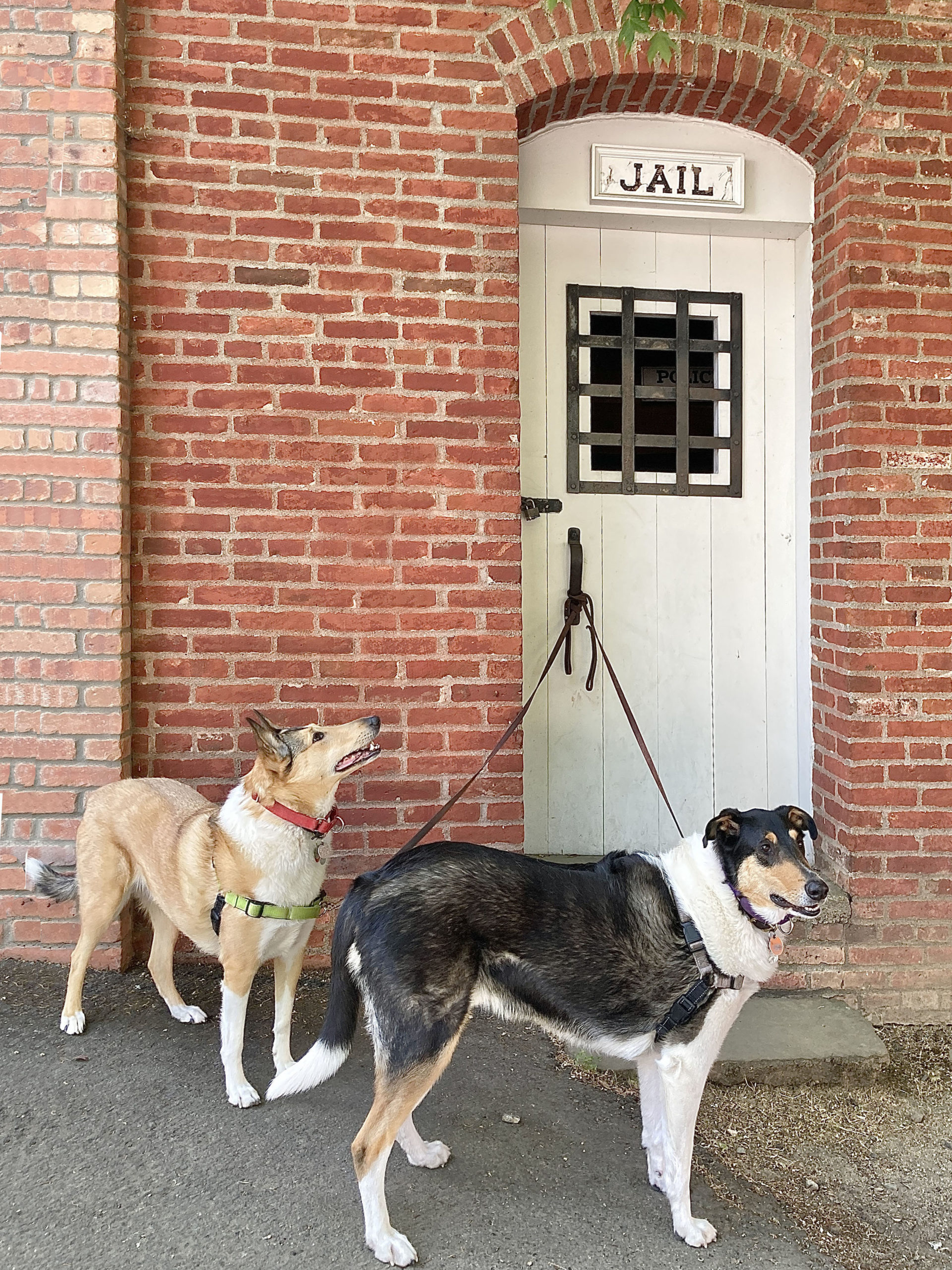 |
“Jail”
Ariel and Caliban are in front of the barred door and “Jail” sign on the Oregon Street side of Jacksonville’s Old City Hall at the corner of S. Oregon and W. Main streets. It’s the doorway to one of 2 “calabooses,” i.e., jail cells, that were incorporated into the building’s 1880s architecture. (The other “calaboose” is accessed from inside the building.) From 1881 until the 1930s or ‘40s, the two cells were used to house the town’s “delinquents.” Translation: it was the town’s drunk tank. However, Ariel, who is known for getting into a bit of mischief, appears to be wondering if she might be seeing the interior sooner rather than later!
A colleague remembered him as “quite a large man, with black hair…who wore that determined look that made the small boy in need of his services feel that he was not to be trifled with.”
Jackson’s house at 235 E. California Street was his second home at that location, constructed in 1873 after a fire took out most of the block. It’s now home to the Miners Bazaar. Jackson’s dentist office was “12 feet east” where Remotion’s tasting room now stands.
The entire corner of California and 5th streets was originally the site of the corral and stables of Cram & Rogers, the company that brought C.C. Beekman to Jacksonville, but from 1857 on, that corner housed a succession of doctors’ offices.
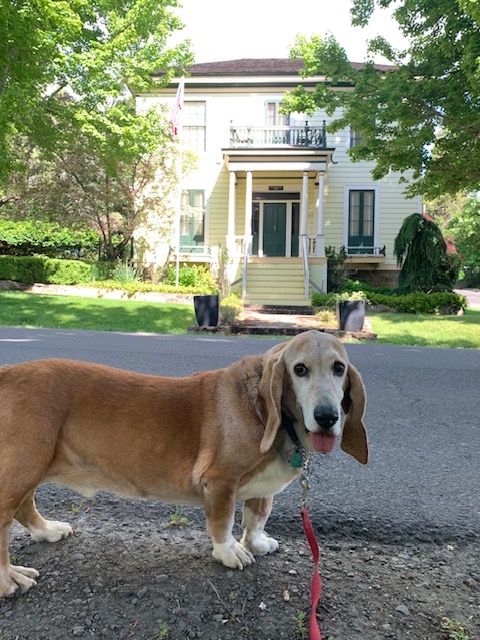 |
Helms House
Trevor is visiting the Italianate style Helms House at the corner of South Oregon and Pine streets. It was built in 1878 by Table Rock Billiard Saloon owner Herman von Helms. An existing cabin was incorporated as kitchen and pantry.
After arriving in Jacksonville in 1856, Helms had purchased an interest in the Table Rock Bakery (the forerunner of his saloon), and in 1866 purchased this corner lot from William Hesse, the original owner of the Bakery.
Helms marriage to Augusta Englebrecht in 1862 had been arranged through the Northern California and Southern Oregon German communities. Both Herman and Augusta were originally from Holstein, Germany, but they met for the first time the day before they wed. Their marriage appears to have been successful, but of their 9 children, only 5 survived to adulthood. Three daughters died in typhoid epidemics; a fourth was murdered by her sister’s estranged husband. Their spirits still linger and this is one of the houses featured on Historic Jacksonville’s “Haunted History” walking tours.
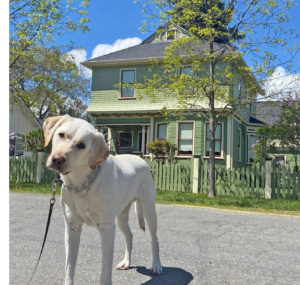 |
The newly painted house (Mozzie definitely admires the new color combo) was built around 1898 by Thomas J. Kenney. Kenney’s father, Daniel M. Kenney, had opened the town’s first trading post in 1852, a tent structure at the corner of Oregon and California streets. His mother was Elizabeth T’Vault, daughter of lawyer, politician, and newspaper publisher William T’Vault.
At age 8, Thomas began working as a “chore boy” in a livery stable, became an apprentice harness maker at age 10, and at 25 opened his own harness and saddle store. He subsequently sold insurance, invested in mines, accumulated considerable property, and conducted a hardware and grocery business becoming one of the town’s leading merchants. He served on the school board and city council, was active in various lodges, and was regarded as one of Jacksonville’s legendary patriarchs, creating his own legacy!
Jaxon is visiting the Applebaker Barn, located at the corner of North 3rd and D streets. It’s one of the few remaining structures directly linked to Jacksonville’s early agricultural economy.
The building was originally a steam grist mill, located in the 800 block of South 3rd Street. Constructed in 1880 at an estimated cost of $11,000, it was described in that December’s Democratic Times newspaper as 3 stories in height with a solid stone foundation. It boasted the “latest most improved machinery” that could grind the “finest quality flour” at the rate of 1,100 pounds of wheat an hour or 150,000 bushels a year—equivalent to all the surplus wheat grown in the Rogue Valley at that time. Businessman Gustav Karewski purchased it in 1881 and within three years it ranked third in the state in flour production. In 1915, Joseph Applebaker dismantled, moved, and reconstructed the reconfigured building at its present location to serve as his blacksmith’s shop.
Actually, we wonder if Jaxon may be more interested in the old jalopy behind him than the barn’s history. He’s hoping he can go for a ride!
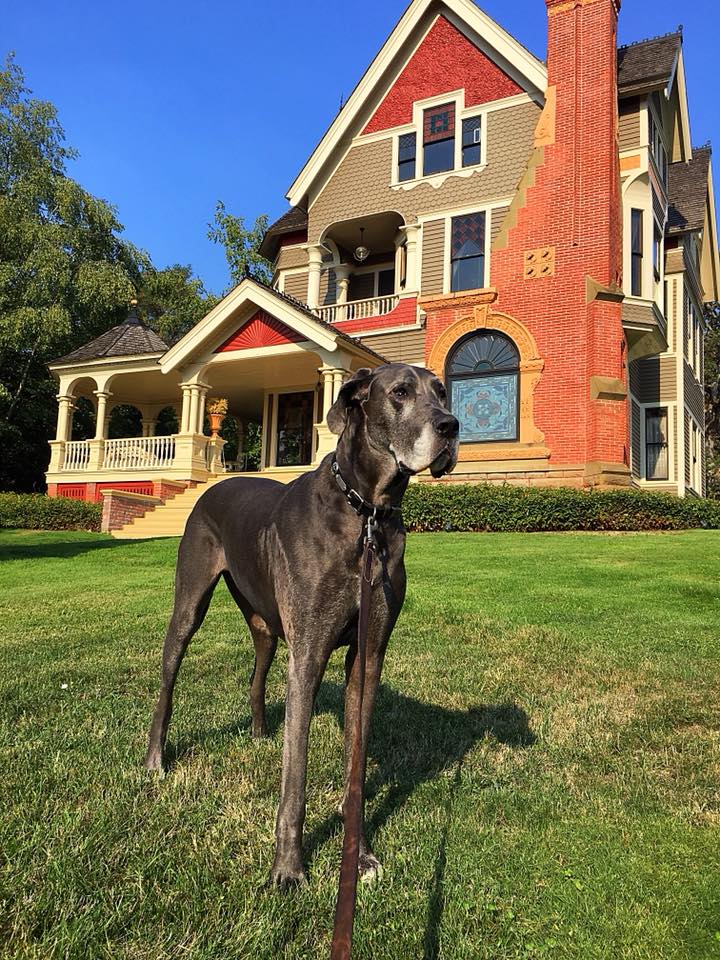
Nunan House
Jacksonville’s famous 4-legged history ambassador, Storm Large, passed away in early April, but over her 7+ years of Walkabout Wednesday outings, she gained a huge fan club and a national reputation. As a legacy, and with the blessing of Storm’s owners, Historic Jacksonville, Inc. is organizing a Walkabout Wednesday Club to continue the tradition. In the meantime, we are sharing some of our favorite outings with Storm from previous years.
This 2019 photo finds Storm at the 1892 Jeremiah Nunan House, located at 635 N. Oregon Street in Jacksonville. When construction began, the local newspaper referred to it as “the most elegant home in Jacksonville.” Contrary to local lore, it was not a kit house ordered from Sears, Roebuck & Company. Sear’s kit homes weren’t produced until 1908. The Nunan House plans were purchased directly from Tennessee architect George F. Barber’s “The Cottage Souvenir” catalog, hence its nickname, “the catalog house.”
Jeremiah Nunan operated a saddle and harness business then later opened a general merchandise store. He was also involved in farming, mining, and fire insurance, and served as the town recorder and police judge.
Nunan built this beautiful Queen Anne style home as a Christmas present for his wife, Delia O’Grady. The two and one-half story Nunan House is a superb example of Queen Anne style architecture with its variety of forms, textures, materials, and colors. “Its unabashed exuberance” also symbolizes Jacksonville’s “history of lusty gold mining and productive agricultural trade.”
